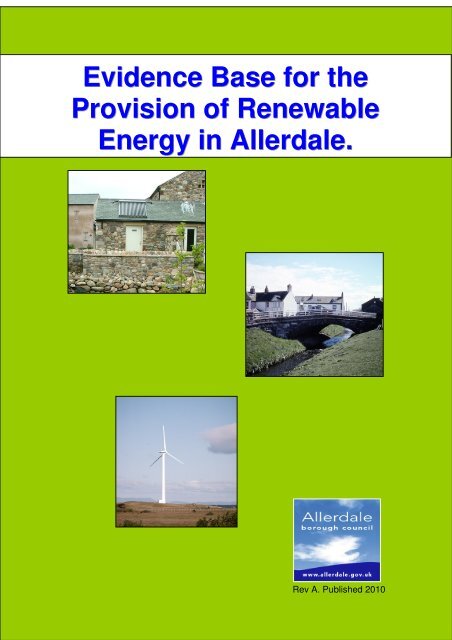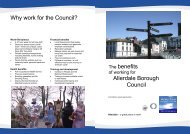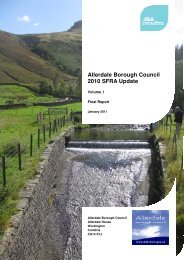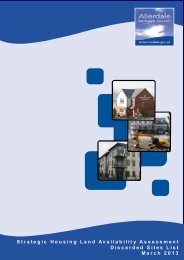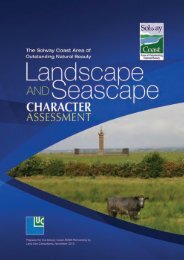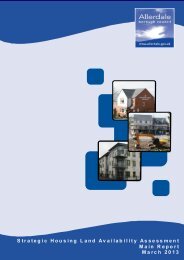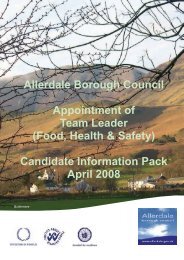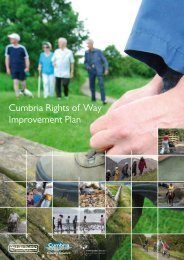Evidence Base for the Provision of Renewable Energy in Allerdale.
Evidence Base for the Provision of Renewable Energy in Allerdale.
Evidence Base for the Provision of Renewable Energy in Allerdale.
You also want an ePaper? Increase the reach of your titles
YUMPU automatically turns print PDFs into web optimized ePapers that Google loves.
Revision to pg 22, Wood Fuels, paragraph 31
ContentsIntroduction Scope 3Assumptions 4Overview <strong>Allerdale</strong>’s assets 5Constra<strong>in</strong>ts 6Progress to Date 7Hydro 8Tidal Barrage 13Turb<strong>in</strong>e 13Wave 16W<strong>in</strong>d 18Biomass Landfill Gasses 21Waste Inc<strong>in</strong>eration 22Wood Burners 22Anaerobic Digesters 23<strong>Energy</strong> Crops 24Heat Pumps Ground Source 28Air Source 28Solar Solar Voltaic 30Passive Heat<strong>in</strong>g 30Solar Hot Water 31Summary <strong>of</strong> Potential Supply 33Best use <strong>of</strong> Resources, Future Scenarios 362020 Generat<strong>in</strong>g Capacity and Scenarios 38Con<strong>for</strong>mity with O<strong>the</strong>r Reports. 39Sources 43Appendices 442
IntroductionScopeThe Cumbria Strategic Partnership's Climate Change Strategy and ActionPlan was agreed by <strong>Allerdale</strong> Borough Council on <strong>the</strong>16th March 2009 alongwith o<strong>the</strong>r partners.Part <strong>of</strong> that commitment was to construct an evidence base <strong>of</strong> <strong>the</strong> localauthority area to support LDF policies that <strong>in</strong>clude assessment <strong>of</strong> <strong>the</strong> area’spotential <strong>for</strong> renewable and low carbon energy sources, scope <strong>for</strong> todecentralise energy, exist<strong>in</strong>g biodiversity and adaptation capacity.The geographical area considered <strong>in</strong>cludes only <strong>the</strong> area <strong>of</strong> <strong>Allerdale</strong> outside<strong>of</strong> <strong>the</strong> national park but <strong>in</strong>cludes areas <strong>of</strong>fshore <strong>in</strong> <strong>the</strong> Solway Firth whichrequire or may require <strong>in</strong>frastructure commitment with<strong>in</strong> <strong>Allerdale</strong>, althoughdelivery <strong>of</strong>f shore is not with<strong>in</strong> <strong>the</strong> boroughs jurisdiction.The aim is to provide guidance on <strong>the</strong> potential with<strong>in</strong> allerdale to convertenergy from renewable resources <strong>in</strong>to useful energy <strong>for</strong> heat<strong>in</strong>g and electricitysupply, where <strong>the</strong> resources are and how large. It will also provide guidanceon scale <strong>of</strong> resources <strong>in</strong> local and national context.The methodology used is similar to that <strong>of</strong> <strong>the</strong> Regional Methodology (2009)but adapted to account <strong>for</strong> <strong>the</strong> local scale where necessary.3
AssumptionsThe issues surround<strong>in</strong>g <strong>the</strong>se technologies are complex and <strong>in</strong>cludeaes<strong>the</strong>tics, f<strong>in</strong>ancial cost, spatial and temporal equity. This assessment willnot address any <strong>of</strong> <strong>the</strong>se issues except to site <strong>the</strong>m as a possible constra<strong>in</strong>t.The assessment will focus upon <strong>the</strong> climate change issues a<strong>for</strong>e mentioned,namely:• potential <strong>for</strong> renewable and low carbon energy sources• scope <strong>for</strong> to decentralise energy• exist<strong>in</strong>g biodiversity• adaptation capacityO<strong>the</strong>r issues are <strong>for</strong> <strong>the</strong> plann<strong>in</strong>g process and developers to address on acase by case basis.Mention <strong>of</strong> a site does not necessarily <strong>in</strong>dicate any <strong>in</strong>tent to build. Thisdocument is <strong>in</strong>tended only to <strong>in</strong><strong>for</strong>m decision makers and policy makers <strong>of</strong>potential resource availability with<strong>in</strong> <strong>Allerdale</strong>.The figures derived must be seen as <strong>in</strong>dicative, not def<strong>in</strong>itive, because <strong>of</strong> <strong>the</strong>many uncerta<strong>in</strong>ties <strong>in</strong>volved <strong>in</strong> predict<strong>in</strong>g natural resources and <strong>the</strong> rapidchanges <strong>in</strong> <strong>the</strong> technologies which can raise efficiency to higher levels.The DECC ‘Total F<strong>in</strong>al <strong>Energy</strong> Consumption at Sub-national Level’ tablesuggests a proportional annual average power requirement <strong>of</strong> 247MW (2007)exclud<strong>in</strong>g transportation. From <strong>the</strong> same report <strong>the</strong> total energy demand <strong>for</strong><strong>Allerdale</strong> suggests a figure <strong>of</strong> 304MW exclud<strong>in</strong>g transportation. Thisdocument will use <strong>the</strong> 304MW figure <strong>for</strong> local need.The unit <strong>of</strong> Watts is preferred <strong>in</strong> this document and conversions from kWh(kilowatt hours) have been made <strong>for</strong> simplicity <strong>of</strong> read<strong>in</strong>g. 1W equates to8.76kWh where <strong>the</strong> usage is measured over 1 year (8760 hours).MW is normally used to measure power while kWh is normally used tomeasure energy. Electricity generation <strong>for</strong> example converts power to energy,hence <strong>the</strong> two terms be<strong>in</strong>g used toge<strong>the</strong>r.Most values exclude transport energy demand/supply except wherespecifically mentioned.The method <strong>of</strong> calculation <strong>for</strong> each technology varies. For example, <strong>the</strong>capacity from wood burn<strong>in</strong>g technologies is dependant upon <strong>the</strong> volume <strong>of</strong>fuel used, <strong>the</strong>re<strong>for</strong>e <strong>the</strong> calculation would be <strong>of</strong> <strong>the</strong> potential resource.Conversely, a heat pump is unrestricted by resource so <strong>the</strong> calculation isbased upon delivery and efficiency <strong>of</strong> <strong>the</strong> technology.4
Overview <strong>of</strong> <strong>the</strong> <strong>Allerdale</strong> Areas<strong>Renewable</strong>s Assets.<strong>Allerdale</strong>’s assets<strong>Allerdale</strong> is sited north west <strong>of</strong> <strong>the</strong> Lakeland fells and so benefits fromelevated sites capable <strong>of</strong> captur<strong>in</strong>g <strong>the</strong> stronger higher altitude w<strong>in</strong>ds. Thew<strong>in</strong>ds found here are some <strong>of</strong> <strong>the</strong> strongest <strong>in</strong> Europe. The hills also <strong>in</strong>creaseprecipitation result<strong>in</strong>g <strong>in</strong> a large number <strong>of</strong> rivers provid<strong>in</strong>g opportunities <strong>for</strong>hydro schemes. These rivers flow to <strong>the</strong> Solway Firth, a large tidal estuaryprovid<strong>in</strong>g opportunities <strong>for</strong> tidal barrages and/or turb<strong>in</strong>es as well as wavepower technologies. Off shore w<strong>in</strong>d turb<strong>in</strong>es are already present on <strong>the</strong> Rob<strong>in</strong>Rigg bank.The area is predom<strong>in</strong>antly rural <strong>in</strong> nature with livestock farm<strong>in</strong>g be<strong>in</strong>g <strong>the</strong>predom<strong>in</strong>ant <strong>in</strong>dustry <strong>in</strong> terms <strong>of</strong> land area. This <strong>in</strong>dustry is one <strong>of</strong> <strong>the</strong> biggestemitters <strong>of</strong> greenhouse gasses contribut<strong>in</strong>g 18% <strong>of</strong> <strong>the</strong> greenhouse gassesemitted globally. (UN FAO 2006) However, <strong>the</strong>re are opportunities <strong>in</strong>anaerobic digestion from <strong>the</strong> waste materials made by animals. There is alsoscope <strong>for</strong> change <strong>of</strong> land use to <strong>for</strong>estry to support wood burn<strong>in</strong>gtechnologies. O<strong>the</strong>r biomass technologies could replace landfill waste.The rural nature <strong>of</strong> many <strong>of</strong> <strong>the</strong> properties <strong>in</strong> <strong>Allerdale</strong> <strong>of</strong>fer opportunities <strong>for</strong><strong>the</strong> low cost <strong>in</strong>stallation <strong>of</strong> ground source heat pumps which can heat waterregardless <strong>of</strong> air temperature.The sun also sh<strong>in</strong>es on <strong>Allerdale</strong> giv<strong>in</strong>g opportunities <strong>for</strong> emerg<strong>in</strong>g solartechnologies.5
Constra<strong>in</strong>tsThe area is valued <strong>for</strong> its natural attributes. The higher ground encompass<strong>in</strong>g<strong>the</strong> Caldbeck Fells and <strong>the</strong> o<strong>the</strong>r Lakeland Fells all fall with<strong>in</strong> <strong>the</strong> Lake DistrictNational Park. While not preclud<strong>in</strong>g development <strong>of</strong> renewable technologies,national parks and AONB’s have <strong>the</strong> highest level <strong>of</strong> protection plac<strong>in</strong>g ahigher value on aes<strong>the</strong>tic values <strong>in</strong> l<strong>in</strong>e with government policy, which bydefault precludes development <strong>of</strong> w<strong>in</strong>d energy <strong>in</strong> <strong>the</strong>se areas.The River Derwent system is designated a site <strong>of</strong> special scientific <strong>in</strong>terest(SSSI), and a SAC, as is Wedholme Flow and o<strong>the</strong>r South Solway Mosses,and <strong>the</strong> Upper Solway mud flats. The Upper Solway Flats are also protectedthrough Ramsar and SPA designation.The coastal area between Maryport to Silloth and Silloth northwards is anarea <strong>of</strong> outstand<strong>in</strong>g natural beauty (AONB) which is protected <strong>in</strong> <strong>the</strong> sameregard as national parks. There are a number <strong>of</strong> County Wildlife Sites toconsider as well. (See appendix 10).A number <strong>of</strong> key species <strong>in</strong>habit <strong>the</strong> area;• Barn Owls• Bats• Great Crested Newts• Hen Harriers• Natterjack Toads• Otters• Red Squirrels• Reptiles• Small Blue Butterflies• W<strong>in</strong>ter<strong>in</strong>g Geese and Swans<strong>Allerdale</strong> is divorced from large population centres, <strong>the</strong> nearest be<strong>in</strong>gNewcastle. This means that import<strong>in</strong>g or export<strong>in</strong>g electricity to o<strong>the</strong>r areasresults <strong>in</strong> higher transmission losses which can account <strong>for</strong> up to 30% <strong>of</strong>primary energy.In terms <strong>of</strong> solar energy, Cumbria is at high latitude result<strong>in</strong>g <strong>in</strong> low <strong>in</strong>solationdur<strong>in</strong>g <strong>the</strong> w<strong>in</strong>ter months. In addition <strong>the</strong> location <strong>of</strong> <strong>the</strong> Cumbrian Fells to <strong>the</strong>south reduces <strong>the</strong> amount <strong>of</strong> time <strong>the</strong> sun is above <strong>the</strong> horizon <strong>in</strong> <strong>the</strong> borough<strong>of</strong> <strong>Allerdale</strong>. This also <strong>in</strong>creases <strong>the</strong> boroughs energy need <strong>in</strong> some places,compared to o<strong>the</strong>r areas with a clear, low ly<strong>in</strong>g sou<strong>the</strong>rly aspect.Similarly, <strong>the</strong> high w<strong>in</strong>d potential will also serve to <strong>in</strong>crease heat<strong>in</strong>g demand.6
Progress to DateIn <strong>the</strong> 2008/2009 AMR it was reported that <strong>Allerdale</strong> had land based w<strong>in</strong>dturb<strong>in</strong>es with a capacity <strong>of</strong> 44.236MW. This is 14.5% <strong>of</strong> <strong>the</strong> local demand <strong>of</strong>304MW.The <strong>of</strong>fshore Rob<strong>in</strong> Rigg Installation provides 90MW which is routed to Flimby<strong>in</strong> <strong>Allerdale</strong> result<strong>in</strong>g <strong>in</strong> a total <strong>of</strong> 14.7 % <strong>of</strong> <strong>Allerdale</strong>’s energy requirementspotentially be<strong>in</strong>g met by w<strong>in</strong>d energy.The amount <strong>of</strong> solar, heat pump, and biomass capacity is unknown as <strong>the</strong>re isno monitor<strong>in</strong>g mechanism <strong>in</strong> place <strong>for</strong> <strong>the</strong>se technologies at household level.The supply routes <strong>for</strong> wood burn<strong>in</strong>g products are well established <strong>in</strong> <strong>the</strong> areawith a substantial potential supply ready to be exploited <strong>in</strong> <strong>the</strong> area.7
Hydro<strong>Allerdale</strong> benefits from some good conditions <strong>for</strong> a range <strong>of</strong> hydro schemes.In <strong>the</strong> north <strong>of</strong> <strong>the</strong> borough <strong>the</strong> rivers tend to issue from <strong>the</strong> Caldbeck fells atabout 200 to 300 meters altitude which falls rapidly to below 60 meters with<strong>in</strong>4 or 5km. This gradient provides a natural head which could be used togenerate electricity us<strong>in</strong>g a range <strong>of</strong> turb<strong>in</strong>e types or even traditional waterwheels. However, <strong>the</strong> average flow <strong>of</strong> water down an <strong>in</strong>dividual stream isprobably relatively low.The power available <strong>in</strong> a stream <strong>of</strong> water is found us<strong>in</strong>g <strong>the</strong> <strong>for</strong>mula;P = η x ρ x g x h x q• P = power (J/s or watts)• η = turb<strong>in</strong>e efficiency (<strong>in</strong>teger)• ρ = density <strong>of</strong> water (kg/m³)• g = acceleration <strong>of</strong> gravity (9.81 m/s²)• h = head (m). For still water, this is <strong>the</strong> difference <strong>in</strong> height between <strong>the</strong><strong>in</strong>let and outlet surfaces. Mov<strong>in</strong>g water has an additional componentadded to account <strong>for</strong> <strong>the</strong> k<strong>in</strong>etic energy <strong>of</strong> <strong>the</strong> flow. The total head equals<strong>the</strong> pressure head plus velocity head.• q = flow rate (m³/s)Velocity head and flow rate are site specific values and require measurementto obta<strong>in</strong> data. Data <strong>for</strong> rivers <strong>in</strong> <strong>Allerdale</strong> is available only <strong>for</strong> <strong>the</strong> RiverDerwent at Camerton, <strong>the</strong> River Cocker at Southwaite Bridge and Scalehill,<strong>the</strong> River Marron at Ullock and <strong>the</strong> River Ellen at Bullgill.In <strong>the</strong> Wigton and Caldbeck areas water mills are known to have operated <strong>in</strong><strong>the</strong> past. At <strong>the</strong>se po<strong>in</strong>ts, streams jo<strong>in</strong> toge<strong>the</strong>r to become small rivers. Thereare a number <strong>of</strong> ways to derive energy from low head schemes which may besuitable <strong>for</strong> <strong>the</strong>se locations requir<strong>in</strong>g m<strong>in</strong>imal change to <strong>the</strong> flow <strong>of</strong> <strong>the</strong>streams, but <strong>the</strong> energy from each is likely to be <strong>in</strong> <strong>the</strong> region <strong>of</strong> only 0.5kW to2kW each, result<strong>in</strong>g <strong>in</strong> a rough estimate <strong>of</strong> 7 to 28kW from sites listed below.River Caldew south <strong>of</strong> SeberghamRiver Wampool at East CurthwaiteSpeet Gill at Forrester FoldWiza Beck at WestwardThornthwaite Beck west <strong>of</strong> High HallPow Gill at Bolton New HousesGill Gooden north <strong>of</strong> Bo<strong>the</strong>l8
Snary Beck on <strong>the</strong> sou<strong>the</strong>rn edge <strong>of</strong> <strong>the</strong> borough is also a suitable locationadd<strong>in</strong>g ano<strong>the</strong>r 0.5 to 2 kWThe larger rivers <strong>in</strong> <strong>the</strong> borough are <strong>the</strong> Ellen, Derwent and Cocker. Flowrates are known <strong>for</strong> <strong>the</strong>se rivers so a more accurate assessment <strong>of</strong> <strong>the</strong>potential power can be made. (Appendices 2 to 5)The river Ellen at Maryport has a flow rate <strong>of</strong> 2.3 m 3 s -1 , so assum<strong>in</strong>g a head <strong>of</strong>1 meterP = 0.65 x 999.1026 x 9.81 x 1 x 2.3 = 14.7kW (Refer to <strong>the</strong> <strong>for</strong>mula above)Add<strong>in</strong>g a weir that provides a two meter head could provide twice this amount,29.4kWAt Dearham Bridge it would be possible to <strong>in</strong>stall a dam with a head <strong>of</strong> 10 to20 meters which would provide 294kW and create a small fresh waterreservoir cover<strong>in</strong>g 32 Ha.The river Cocker has a flow rate <strong>of</strong> 5.34 m 3 s -1 which could provide 34kW witha 1 meter head.Most <strong>of</strong> <strong>the</strong> river Cocker lies with<strong>in</strong> <strong>the</strong> Lake District National Park but exits<strong>the</strong> park at Southwaite where it enters a small valley which runs <strong>in</strong>toCockermouth. This valley could susta<strong>in</strong> a dam scheme provid<strong>in</strong>g a 5 to 10meter head which could provide 170kW to 340kW close to Cockermouth.The river Derwent is <strong>the</strong> largest <strong>of</strong> <strong>the</strong> rivers with an average flow rate <strong>of</strong>26.23 m 3 s -1 which could supply 167kW with a 1 meter head at Camerton.There is potential to create a 10 meter head south <strong>of</strong> Wood Hall Farm north <strong>of</strong>Cockermouth which could supply <strong>in</strong> <strong>the</strong> region <strong>of</strong> 1 MW to 1.7MW (depend<strong>in</strong>gon flow rate at this location, data not available). There is an exist<strong>in</strong>g weirsouth <strong>of</strong> Papcastle which can be assumed to have a 167kW capacity. There isano<strong>the</strong>r weir north west <strong>of</strong> Broughton Cross add<strong>in</strong>g ano<strong>the</strong>r 167kW. AtWork<strong>in</strong>gton <strong>the</strong> river was historically managed and mill races can be foundwhich run to <strong>the</strong> harbour. It may be possible to harness energy from <strong>the</strong>seexist<strong>in</strong>g systems but it is difficult to gauge how much energy might beretrieved but it is likely to be small. One mill race passes <strong>Allerdale</strong> House, <strong>the</strong>ma<strong>in</strong> <strong>of</strong>fice <strong>for</strong> <strong>Allerdale</strong> Borough Council.The River Marron, a tributary <strong>of</strong> <strong>the</strong> Derwent, has a flow rate <strong>of</strong> 0.81 m 3 s -1which has an energy potential <strong>of</strong> 5.2kW with a 1 meter head. However, <strong>the</strong>river runs through a deep valley west <strong>of</strong> Ullock which could generate a head<strong>of</strong> up to 20 meters which could supply 104 kW. This valley supports a <strong>for</strong>merfish farm and so has a run <strong>of</strong>f which could be used as ei<strong>the</strong>r a smaller hydroscheme or a fish run around any dam.Wiza Beck at Old Carlisle runs through a valley giv<strong>in</strong>g potential <strong>for</strong> a sizabledam with 15 to 20 meter head. The flow rate is unknown <strong>for</strong> this stream butassum<strong>in</strong>g a low flow rate <strong>of</strong> 1 m 3 s -1 <strong>the</strong> potential energy provided wouldamount to 127kW9
Summary <strong>of</strong> Potential Resource (Capacity)Locations Low Estimate (MW) High Estimate (MW)Low head Schemes 0.011 0.046River Ellen 0.025 0.446River Cocker 0.052 0.523River Derwent 0.257 3.077Marron 0.008 0.154Wiza Beck 0 0.2Total 0.353 4.799Most Hydro schemes would <strong>in</strong>volve substantial capital schemes where weirsor dams are build to channel or store water. The carbon emissions associatedwith construction will <strong>the</strong>re<strong>for</strong>e be high but <strong>the</strong> lifespan <strong>of</strong> <strong>the</strong> developmentwould likely be <strong>in</strong> <strong>the</strong> order <strong>of</strong> 50 to 100 years. Dam schemes can causegreenhouse emissions caused by <strong>the</strong> rott<strong>in</strong>g <strong>of</strong> dead vegetation <strong>in</strong> <strong>in</strong>undatedareas. This would be m<strong>in</strong>imal <strong>in</strong> <strong>the</strong> schemes mentioned but some loss <strong>of</strong>woodland could occur which would need to be mitigated.The Environment agency document ‘Opportunity and EnvironmentalSensitivity <strong>for</strong> Hydropower <strong>in</strong> England and Wales’ identified 31MW <strong>of</strong> potentialresource with<strong>in</strong> <strong>Allerdale</strong> <strong>of</strong> which only 11% was not <strong>of</strong> high sensitivity,equivalent to 3.41MW <strong>in</strong>clud<strong>in</strong>g <strong>the</strong> national park (low head schemes only).Deliverable <strong>Energy</strong> (With Efficiency Factor)Locations Low Estimate (MW) High Estimate (MW)Low head Schemes 0.006 0.023River Ellen 0.013 0.223River Cocker 0.026 0.262River Derwent 0.129 1.539Marron 0.004 0.077Wiza Beck 0 0.1Total 0.177 2.4The load factor <strong>for</strong> hydro schemes is about 50%, dependant upon ra<strong>in</strong>fallwith<strong>in</strong> <strong>the</strong> catchment area.Regional National Breakdown (Capacity)RegionalNational4.799MW0MW10
Decentralisation <strong>of</strong> <strong>Energy</strong> (Delivered)Locations LowEstimate(MW)HighEstimate(MW)EstimatedDemand(MW)*%(Aga<strong>in</strong>stLowEstimate)%(Aga<strong>in</strong>stHighEstimate)Low head 0.006 0.023 304 0.002 0.01SchemesRiver Ellen 0.013 0.223 304 0.004 0.07River Cocker 0.026 0.262 304 0.01 0.09River 0.129 1.539 304 0.05 0.51DerwentMarron 0.004 0.077 304 0.001 0.03Wiza Beck 0 0.1 304 0 0.04Total 0.177 2.4*The boroughs energy usage exclud<strong>in</strong>g transport, 2007.Aga<strong>in</strong>st <strong>the</strong> high estimate all locales comb<strong>in</strong>ed supply just under 1% <strong>of</strong><strong>Allerdale</strong>’s demand which is 304MW. Two thirds <strong>of</strong> this supply comes from <strong>the</strong>river Derwent which passes through Cockermouth and Work<strong>in</strong>gton.There are many streams dispersed through <strong>the</strong> borough which could beutilised but are limited by <strong>the</strong> volume <strong>of</strong> water flow<strong>in</strong>g through <strong>the</strong>m.BiodiversityLow head devices are unlikely to have much effect o<strong>the</strong>r than to temporarilydivert a portion <strong>of</strong> a stream through it, although divert<strong>in</strong>g too much water couldhamper or prevent <strong>the</strong> migration <strong>of</strong> aquatic life.Dams would need to <strong>in</strong>clude fish runs to allow fish to travel past <strong>the</strong> dam. Thisis particularly important <strong>for</strong> <strong>the</strong> Derwent river system which leads <strong>in</strong>to 2 lakesand <strong>in</strong>cludes numerous tributaries. Inundation <strong>of</strong> land could also destroyimportant riverside habitat, both aquatic and terrestrial. Care would need to betaken to assess <strong>the</strong> wildlife presence and replant or transplant species wherenecessary to allow <strong>for</strong> migration <strong>of</strong> wildlife once <strong>in</strong>undation takes place.The construction <strong>of</strong> dams creates large bodies <strong>of</strong> water which can benefitwildlife <strong>in</strong> association with o<strong>the</strong>r landscape management such as treeplant<strong>in</strong>g. The river Derwent, which is <strong>the</strong> largest potential resource, is a SSSI.In terms <strong>of</strong> <strong>the</strong> scale <strong>of</strong> impact aga<strong>in</strong>st contribution to <strong>the</strong> energy mix, <strong>the</strong>environmental impact <strong>of</strong> large head schemes is proportionately greater than isjustifiable. It is unlikely that high head schemes would be considered on thisbasis.11
Adaptation to Climate ChangeThe effect <strong>of</strong> climate change is difficult to predict. The important wea<strong>the</strong>rfeature associated with hydro schemes is ra<strong>in</strong>fall. This may <strong>in</strong>crease ordecrease.Increased ra<strong>in</strong>fall will lead to more <strong>in</strong>stances <strong>of</strong> flash flood<strong>in</strong>g. Dams havebeen successfully used to reduce flood risk <strong>in</strong> many areas and may beimportant features <strong>in</strong> prevent<strong>in</strong>g events like <strong>the</strong> 2005 and 2009 flood<strong>in</strong>g whichseverely effected <strong>Allerdale</strong>. Increased ra<strong>in</strong>fall would also <strong>in</strong>crease <strong>the</strong> capacity<strong>of</strong> any hydro <strong>in</strong>stallation <strong>the</strong>reby reduc<strong>in</strong>g carbon emissions fur<strong>the</strong>r.Reduced ra<strong>in</strong>fall would lead to water shortages which could be mitigated with<strong>the</strong> presence <strong>of</strong> fresh water reservoirs through <strong>the</strong> borough. This may lead to<strong>the</strong> reduction <strong>of</strong> energy derived from an <strong>in</strong>stallation but energy can beobta<strong>in</strong>ed from <strong>the</strong> flow <strong>of</strong> water from <strong>the</strong> reservoir to end users ensur<strong>in</strong>g somecapacity is achieved. West Cumbria is <strong>the</strong> only area <strong>in</strong> <strong>the</strong> North West <strong>of</strong>England currently identified as experienc<strong>in</strong>g water stress.12
TidalBarrageA tidal barrage is similar to a dam but relies on captur<strong>in</strong>g tidal water <strong>the</strong>nreleas<strong>in</strong>g it. The capacity <strong>in</strong> <strong>the</strong> Solway Firth is enormous.The diagram <strong>in</strong> appendix 7 shows areas <strong>of</strong> potential tidal power around <strong>the</strong>UK. The Severn Estuary <strong>in</strong> yellow has <strong>the</strong> greatest potential, followed by <strong>the</strong>Solway Firth. To maximise <strong>the</strong> energy capture from <strong>the</strong> Solway Firth wouldrequire a barrage to be built from Harr<strong>in</strong>gton to Balmae near Kirkcudbright, adistance <strong>of</strong> about 21 miles, supply<strong>in</strong>g up to 8GW <strong>of</strong> power (Catterson andBroach). This equates to 4.4% <strong>of</strong> <strong>the</strong> UK’s energy requirements, 2631% <strong>of</strong><strong>Allerdale</strong>’s energy needs.The recently published Solway Firth <strong>Energy</strong> Feasibility Study identified 6GWand 3GW schemes as be<strong>in</strong>g <strong>the</strong> most technically and f<strong>in</strong>ancially feasibleoptions. It supposes major environmental impact but does not <strong>in</strong>clude detailedmodell<strong>in</strong>g to back this up. It may still be that a barrage <strong>of</strong> <strong>the</strong> correct scalerunn<strong>in</strong>g on a flood and ebb mode could operate without effect<strong>in</strong>g <strong>the</strong>environment too much. It is impossible to know without a detailed design ledimpact assessment <strong>in</strong>clud<strong>in</strong>g modell<strong>in</strong>g.A tidal fence scheme would produce 20% less power (4.8GW) but would nothave <strong>the</strong> same environmental impact potential. (Gif<strong>for</strong>d)The only proposal <strong>for</strong> a barrage <strong>in</strong> <strong>the</strong> Solway Firth to date is <strong>the</strong> Solway<strong>Energy</strong> Gateway which, accord<strong>in</strong>g to The University <strong>of</strong> Liverpool, couldgenerate 250MW to 300MW (probably <strong>in</strong>clud<strong>in</strong>g a sizable fresh water head <strong>in</strong>addition to <strong>the</strong> tidal head). It would <strong>in</strong>volve build<strong>in</strong>g a barrage from Bownesson Solway to Annan. Given that <strong>the</strong> area is protected as a Ramsar site, SPAand SSSI as well as be<strong>in</strong>g part <strong>of</strong> an AONB it is likely that any scheme <strong>in</strong> thislocation would be on a smaller scale <strong>of</strong> perhaps 150MW which would berouted to Annan <strong>in</strong> Scotland.Turb<strong>in</strong>eTidal Turb<strong>in</strong>es are be<strong>in</strong>g developed which operate <strong>in</strong> a similar way as w<strong>in</strong>dturb<strong>in</strong>es. The benefits over w<strong>in</strong>d are that tidal power is more consistent andpredictable and because <strong>the</strong> turb<strong>in</strong>e is under water <strong>the</strong>re is less visual impact.The obstacles <strong>in</strong>clude hazards to shipp<strong>in</strong>g and <strong>the</strong> harsh operat<strong>in</strong>genvironment. However, a 1MW turb<strong>in</strong>e has been successfully tested <strong>in</strong> UKwaters and fur<strong>the</strong>r tests are cont<strong>in</strong>u<strong>in</strong>g. A 24 km 2 area <strong>of</strong> <strong>Allerdale</strong>’s shorel<strong>in</strong>eat 15m -20m depth has an energy potential <strong>of</strong> 6kW/m 2 which equates to144MW <strong>of</strong> potential energy which could be tapped us<strong>in</strong>g this technology.However, this is <strong>the</strong> technical limit <strong>in</strong> terms <strong>of</strong> water depth <strong>for</strong> this technologyso fur<strong>the</strong>r development would be needed to utilise this resource.There are also proposals to attach 500kw tidal turb<strong>in</strong>es to <strong>the</strong> base <strong>of</strong> <strong>of</strong>fshore w<strong>in</strong>d turb<strong>in</strong>es. Rob<strong>in</strong> Rigg currently has 30 turb<strong>in</strong>es so <strong>the</strong> potential is<strong>for</strong> 15MW <strong>of</strong> capacity. There is <strong>the</strong> possibility that this would <strong>in</strong>crease by 300turb<strong>in</strong>es provid<strong>in</strong>g an additional 150MW.13
Summary <strong>of</strong> Potential Resource (Capacity)Locations Low Estimate (MW) High Estimate (MW)<strong>Energy</strong> Gateway 100 to Scotland 300 to ScotlandSolway Barrage 0 6000 to 8000Off <strong>Allerdale</strong> (Turb<strong>in</strong>e) 50 144Rob<strong>in</strong> Rigg 15 150Total 165 8594For barrage schemes construction costs are very high but like dams <strong>the</strong>yhave long life spans and can fulfil secondary roles such as road l<strong>in</strong>ks.Turb<strong>in</strong>es are less costly but would be less efficient <strong>in</strong> utilis<strong>in</strong>g <strong>the</strong> resourceavailable.Deliverable <strong>Energy</strong> (With Efficiency Factor)Locations Low Estimate (MW) High Estimate (MW)<strong>Energy</strong> Gateway 85 to Scotland 255 to ScotlandSolway Barrage 0 5100Off <strong>Allerdale</strong> (Turb<strong>in</strong>e) 42.5 122.4Rob<strong>in</strong> Rigg 12.8 127.5Total 140.3 5745.2Tides, unlike w<strong>in</strong>d, are predictable and consistent except <strong>for</strong> a slack periodwhen <strong>the</strong> tide turns. The efficiency is <strong>the</strong>re<strong>for</strong>e high. 85% efficiency has beenassumed <strong>for</strong> <strong>the</strong>se calculations.Regional National Breakdown (Capacity)RegionalNational0MW8594MWDecentralisation <strong>of</strong> <strong>Energy</strong> (Delivered)Locations LowEstimate(MW)HighEstimate(MW)EstimatedDemand(MW)*%(Aga<strong>in</strong>stLowEstimate)%(Aga<strong>in</strong>stHighEstimate)<strong>Energy</strong> 85 to Scotland 255 to Scotland 304 28 84GatewaySolway 0 5100 304 0 1678BarrageOff <strong>Allerdale</strong> 42.5 122.4 304 14 40(Turb<strong>in</strong>e)Rob<strong>in</strong> Rigg 12.8 127.5 304 4 42Total 140.3 5745.2 304Be<strong>in</strong>g <strong>of</strong>f shore <strong>the</strong> energy generated would not be close to any majorconurbation but on a regional basis <strong>the</strong> energy derived from <strong>the</strong> Solway Firthcould supply a large proportion <strong>of</strong> demand. The low estimate would supply54% <strong>of</strong> <strong>Allerdale</strong>’s energy needs while <strong>the</strong> high estimate would supply 4.7% <strong>of</strong><strong>the</strong> nation’s energy requirements, essentially centralis<strong>in</strong>g a big chunk <strong>of</strong> <strong>the</strong>nations energy supply ra<strong>the</strong>r than decentralis<strong>in</strong>g.14
BiodiversityTidal flow devices are claimed not to effect aquatic species. The blades rotatemuch slower than w<strong>in</strong>d turb<strong>in</strong>es and most species that might be at risk havesensory ability to perceive and avoid <strong>the</strong> turb<strong>in</strong>es. Additionally <strong>the</strong> pylonsprovide a reef type habitat <strong>for</strong> some species as well as creat<strong>in</strong>g a fish<strong>in</strong>gexclusion zone which can benefit mar<strong>in</strong>e habitats.Barrages are controversial <strong>in</strong> that <strong>the</strong>y have a wide rang<strong>in</strong>g effect uponhabitats. On <strong>the</strong> Solway firth <strong>the</strong> major concerns would be <strong>in</strong>undation <strong>of</strong> <strong>the</strong>mud flats which are important feed<strong>in</strong>g habitats <strong>for</strong> birds which w<strong>in</strong>ter on <strong>the</strong>Solway Firth (some exclusively), and destruction <strong>of</strong> raised bog, particularly <strong>in</strong><strong>the</strong> upper reaches <strong>of</strong> <strong>the</strong> Solway Firth above Silloth. They can obstruct <strong>the</strong>migration <strong>of</strong> mar<strong>in</strong>e species, potentially affect<strong>in</strong>g spawn<strong>in</strong>g, and deplet<strong>in</strong>grivers <strong>of</strong> <strong>the</strong>ir fish stocks. Barrages would change <strong>the</strong> tidal range <strong>of</strong> <strong>the</strong>estuary and it is difficult to predict <strong>the</strong> effect this would have on <strong>the</strong> varioushabitats found <strong>in</strong> such a large geographical area. However, a well designedscheme could overcome <strong>the</strong>se issues.Adaptation to Climate ChangeBarrages could be used to mitigate <strong>the</strong> effects <strong>of</strong> flood<strong>in</strong>g and tidal surge byreduc<strong>in</strong>g <strong>the</strong> head on <strong>the</strong> upper side <strong>of</strong> <strong>the</strong> barrage when high ra<strong>in</strong>fall ispredicted or by block<strong>in</strong>g a significant surge. However, this <strong>in</strong>creases <strong>the</strong> headon <strong>the</strong> lower side <strong>of</strong> <strong>the</strong> barrage, potentially exacerbat<strong>in</strong>g problems <strong>for</strong>communities on that side <strong>of</strong> <strong>the</strong> barrage.Tidal energy has <strong>the</strong> potential to supply a large proportion <strong>of</strong> <strong>the</strong> nationsenergy needs, replac<strong>in</strong>g fossil fuels <strong>in</strong> provid<strong>in</strong>g base loads to <strong>the</strong> nationalgrid. While not consistent, tidal energy is predictable and reliable but whentides turn <strong>the</strong> energy potential falls to zero, so large scale Solway schemesmust work alongside schemes <strong>in</strong> Morecambe Bay, Merseyside and <strong>the</strong>Severn <strong>in</strong> order to give a reasonable, harmonised national supply.Barrages would also block storm waves, mak<strong>in</strong>g <strong>the</strong> water stored beh<strong>in</strong>d <strong>the</strong>barrage calmer.15
WaveWave energy is <strong>in</strong> development phase. No absolute data is available <strong>for</strong>potential supply and <strong>the</strong> ma<strong>in</strong> focus <strong>of</strong> development is likely to be elsewhere,but <strong>the</strong> Atlas <strong>of</strong> UK Mar<strong>in</strong>e <strong>Renewable</strong> <strong>Energy</strong> Resources identifies <strong>the</strong> waveenergy <strong>in</strong> <strong>the</strong> Solway Firth to be about 2.5kW/m. Follow<strong>in</strong>g <strong>the</strong> same l<strong>in</strong>e as<strong>the</strong> potential tidal barrage across <strong>the</strong> Solway Firth which is 21 miles long(33km) this would have a potential energy value <strong>of</strong> 84.5 MW, compared to8000MW <strong>for</strong> a barrage. The two would not be mutually compatible as wavesneed large distances to propagate. Barrages would get <strong>in</strong> <strong>the</strong> way <strong>of</strong> thisfur<strong>the</strong>r up <strong>the</strong> Solway estuary. There could be a useful energy supply sourcedfrom <strong>in</strong> front <strong>of</strong> a barrage with <strong>the</strong> barrage provid<strong>in</strong>g <strong>the</strong> correct conditions <strong>for</strong>wave energy devices and a closer l<strong>in</strong>k to energy supply routes.Summary <strong>of</strong> Potential Resource (Capacity)Locations Low Estimate (MW) High Estimate (MW)Solway Barrage L<strong>in</strong>k 0 84.5The estimate <strong>for</strong> wave energy is reliant upon o<strong>the</strong>r <strong>in</strong>frastructure be<strong>in</strong>g <strong>in</strong>place which might create conditions suitable <strong>for</strong> wave farm<strong>in</strong>g.Deliverable <strong>Energy</strong>Locations Low Estimate (MW) High Estimate (MW)Solway Barrage L<strong>in</strong>k 0 21Regional National BreakdownRegional0MWNational84.5MWDecentralisation <strong>of</strong> <strong>Energy</strong> (Delivered)Locations LowEstimate(MW)HighEstimate(MW)EstimatedDemand(MW)%(Aga<strong>in</strong>stLowEstimate)%(Aga<strong>in</strong>stHighEstimate)Solway Barrage 0 21 304 0 7L<strong>in</strong>kOffshore systems are divorced from <strong>the</strong> po<strong>in</strong>t <strong>of</strong> use but <strong>the</strong>re is <strong>the</strong>oreticalpotential to generate significant amounts <strong>of</strong> power to supply regional demandpossibly l<strong>in</strong>ked by a barrage scheme’s <strong>in</strong>frastructure.BiodiversityWhile some technologies appear passive, o<strong>the</strong>rs are potentially dangerous tomar<strong>in</strong>e animals. There are a wide range <strong>of</strong> designs so assessment wouldneed to be made aga<strong>in</strong>st <strong>the</strong> design be<strong>in</strong>g utilised.16
Adaptation to Climate ChangeWave energy shares some characteristics with w<strong>in</strong>d energy <strong>in</strong> that <strong>the</strong>re arenot always waves, and <strong>the</strong> power derived is <strong>in</strong>consistent and unpredictable.However, <strong>the</strong> energy is entirely renewable and does not add greenhousegasses to <strong>the</strong> atmosphere. It could serve a secondary function <strong>in</strong> remov<strong>in</strong>gsome <strong>of</strong> <strong>the</strong> energy from storm waves, reduc<strong>in</strong>g damage elsewhere whichcould be beneficial to coastal defence.17
W<strong>in</strong>dIn respect to w<strong>in</strong>d speeds Cumbria is one <strong>of</strong> <strong>the</strong> best sites to locate w<strong>in</strong>denergy capture devices <strong>in</strong> England. The map <strong>in</strong> appendix 9 demonstratesthat most <strong>of</strong> England and Wales has a average w<strong>in</strong>d speed below 6m/s whilemost <strong>of</strong> Cumbria and Northumberland has a average w<strong>in</strong>d speed above 6m/sup to above 10m/s <strong>in</strong> some locations (similar to Scotland as a whole)Much <strong>of</strong> this area is covered by national parks, preclud<strong>in</strong>g large scale w<strong>in</strong>ddevelopments, but <strong>the</strong> areas covered by <strong>Allerdale</strong>, some <strong>of</strong> <strong>the</strong> North Eastand <strong>the</strong> western fr<strong>in</strong>ge <strong>of</strong> Lancashire have large areas <strong>of</strong> land with averagew<strong>in</strong>d speeds above 6m/s. Higher w<strong>in</strong>d speeds <strong>in</strong>crease <strong>the</strong> energy capturedfrom a device mak<strong>in</strong>g <strong>the</strong> cost per unit <strong>of</strong> energy produced cheaper. Mostlarge modern w<strong>in</strong>d turb<strong>in</strong>es like to operate at above 6.5m/s. <strong>Allerdale</strong> outside<strong>of</strong> <strong>the</strong> national park is <strong>the</strong>re<strong>for</strong>e wholly with<strong>in</strong> one <strong>of</strong> <strong>the</strong> most favourablelocations <strong>for</strong> onshore w<strong>in</strong>d energy <strong>in</strong> <strong>the</strong> UK.However, <strong>the</strong> vast majority <strong>of</strong> <strong>the</strong> area <strong>of</strong> <strong>Allerdale</strong> is with<strong>in</strong> an air trafficcontrol area. On 19 th November 2008 NATS stated that <strong>the</strong> exist<strong>in</strong>g w<strong>in</strong>ddevelopments <strong>in</strong> <strong>Allerdale</strong> were creat<strong>in</strong>g false plots. While some level <strong>of</strong> falseplots was acceptable, <strong>the</strong> limit <strong>of</strong> safety had been reached. Air traffic control iscited as an exclusion constra<strong>in</strong>t with<strong>in</strong> <strong>the</strong> regional methodology <strong>for</strong>establish<strong>in</strong>g capacity so <strong>the</strong> total future capacity must be considered to bezero <strong>for</strong> large w<strong>in</strong>d turb<strong>in</strong>es until such time as acceptable mitigation can beemployed. This constra<strong>in</strong>t applies down to a height <strong>of</strong> 20m so only very smallmicro renewable systems are now viable.The onshore w<strong>in</strong>d capacity with<strong>in</strong> <strong>Allerdale</strong> now stands at 14.5% <strong>of</strong> <strong>Allerdale</strong>’sneeds with <strong>the</strong> <strong>of</strong>fshore Rob<strong>in</strong> Rigg development <strong>in</strong>creas<strong>in</strong>g this to 44.2%.Crown Estates have <strong>in</strong>dicated that <strong>the</strong> Rob<strong>in</strong> Rigg site could be <strong>in</strong>creased by300 units which could provide 990MW <strong>of</strong> capacity.Us<strong>in</strong>g <strong>the</strong> criteria set out <strong>in</strong> <strong>the</strong> regional methodology a figure <strong>for</strong> micro w<strong>in</strong>dschemes based on <strong>the</strong> number <strong>of</strong> properties and location based constra<strong>in</strong>tscame to a value <strong>of</strong> 63MW18
Summary <strong>of</strong> Potential Resource (Capacity)Locations Low Estimate (MW) High Estimate (MW)Onshore 44.24 44.24Solway 90 990Farm<strong>in</strong>g 0.03 14.32O<strong>the</strong>r Micro W<strong>in</strong>d 0 63Total 134.27 1111.56A large amount <strong>of</strong> capacity is already <strong>in</strong> place as expressed by <strong>the</strong> lowestimate which assumes no fur<strong>the</strong>r development. The higher Solwayestimate is based on a real allocation <strong>in</strong> Scottish Territorial Waters through anexclusivity agreement. (BWEA, <strong>of</strong>fshore turb<strong>in</strong>es list). A sizable quantity <strong>of</strong>w<strong>in</strong>d energy can be harvested through small 15kW turb<strong>in</strong>es located at <strong>the</strong> 955rural bus<strong>in</strong>esses located <strong>in</strong> <strong>Allerdale</strong> (DEFRA 2005 figures).Deliverable <strong>Energy</strong>Locations Low Estimate (MW) High Estimate (MW)Onshore 13.27 13.27Solway 27 297Farm<strong>in</strong>g 0.009 4.3O<strong>the</strong>r Micro W<strong>in</strong>d 0 18.9Total 40.3 333.4Rated capacity does not take <strong>in</strong>to effect <strong>the</strong> <strong>in</strong>consistency <strong>of</strong> w<strong>in</strong>d speed.Convention dictates that an efficiency factor <strong>of</strong> 0.3 is applied which wouldresult <strong>in</strong> a net delivery equivalent to 333MW although 40% is also possiblewhich would deliver 454.9MW. This is purely dependant upon <strong>the</strong> behaviour<strong>of</strong> <strong>the</strong> w<strong>in</strong>d.Regional National BreakdownRegionalNational121.5MW990MWOff shore w<strong>in</strong>d energy contributes to national renewable energy targets andare handled by <strong>the</strong> Infrastructure Plann<strong>in</strong>g Commission, not local plann<strong>in</strong>gauthorities.19
Decentralisation <strong>of</strong> <strong>Energy</strong>Locations LowEstimate(MW)HighEstimate(MW)EstimatedDemand(MW)%(Aga<strong>in</strong>stLowEstimate)%(Aga<strong>in</strong>stHighEstimate)Onshore 13.27 13.27 304 4.36 4.36Solway 27 297 304 8.88 97.7Farm<strong>in</strong>g 0.009 4.3 304 0.003 1.41O<strong>the</strong>r Micro W<strong>in</strong>d 0 18.9 304 0 6.22Total 40.3 333.4With <strong>the</strong> 0.3 efficiency assumptions applied to <strong>the</strong>se figures <strong>the</strong> onshoreestimate reduces to 4% and <strong>the</strong> <strong>of</strong>fshore high estimate to 98%.The Solway scheme is considered to be regional <strong>in</strong> nature due to its scale.Onshore turb<strong>in</strong>es are spread throughout <strong>the</strong> borough and <strong>the</strong> Cumbria W<strong>in</strong>d<strong>Energy</strong> SPD should ensure that any new developments are spread evenlyacross <strong>the</strong> borough so <strong>the</strong> sum amount can be applied to <strong>the</strong> borough as awhole. This may result <strong>in</strong> an <strong>in</strong>crease <strong>in</strong> capacity nearer Maryport and Wigton.Smaller turb<strong>in</strong>es could be located at farms and o<strong>the</strong>r remote <strong>in</strong>stallations suchas schools and hospitals and rural hous<strong>in</strong>g to power <strong>the</strong>ir own local needswith spare capacity go<strong>in</strong>g to <strong>the</strong> national grid. Ne<strong>the</strong>rhall School <strong>in</strong> Maryportand Cockermouth School currently have smaller turb<strong>in</strong>es <strong>in</strong>stalled.BiodiversityThe ma<strong>in</strong> concern is <strong>the</strong> effect upon birds <strong>in</strong> flight. While small birds are ableto dodge <strong>the</strong> rotat<strong>in</strong>g blades, large birds like swans and geese cannot. Forthis reason <strong>the</strong> area around <strong>the</strong> upper Solway flats is unsuitable as this is aw<strong>in</strong>ter<strong>in</strong>g ground <strong>for</strong> <strong>the</strong>se birds which congregate <strong>in</strong> large numbers at thissite. The <strong>of</strong>fshore turb<strong>in</strong>e towers have <strong>the</strong> positive effect <strong>of</strong> creat<strong>in</strong>g a reefenvironment which is helped by <strong>the</strong> exclusion <strong>of</strong> fish<strong>in</strong>g around <strong>the</strong> turb<strong>in</strong>e.The threat to British bats is uncerta<strong>in</strong> but Natural England has publishedguidance to help mitigate possible damage. (TIN051)The base <strong>of</strong> <strong>the</strong> turb<strong>in</strong>e is a concrete block, set <strong>in</strong>to <strong>the</strong> ground. Theconstruction processes <strong>of</strong> <strong>the</strong> larger turb<strong>in</strong>es cause significant damage to <strong>the</strong>area around <strong>the</strong>m. Construction <strong>of</strong> <strong>the</strong> Seaton w<strong>in</strong>d farm <strong>for</strong> example mayhave caused <strong>the</strong> loss <strong>of</strong> Small Blue Butterflies through unsympa<strong>the</strong>ticconstruction activities accord<strong>in</strong>g to Butterfly Conservation UK, soconsideration does need to be given to this, although <strong>the</strong> turb<strong>in</strong>es <strong>the</strong>mselveshave no direct effect on such species while <strong>in</strong> operation.When <strong>in</strong> proximity to trees, hedges and water bodies bat surveys arerequired.Adaptation to Climate ChangeW<strong>in</strong>d technology is a proven technology and is lead<strong>in</strong>g <strong>the</strong> way <strong>in</strong> terms <strong>of</strong>provid<strong>in</strong>g renewable energy <strong>in</strong> <strong>the</strong> UK, but <strong>the</strong> overall contribution to date issmall, about 2.7% <strong>of</strong> UK demand.20
BiomassFor most <strong>of</strong> modern human history we have used biomass to provide ourenergy needs through <strong>the</strong> burn<strong>in</strong>g <strong>of</strong> wood <strong>for</strong> heat<strong>in</strong>g, cook<strong>in</strong>g and light.Wood is still a major source <strong>of</strong> energy <strong>in</strong> <strong>the</strong> third world. O<strong>the</strong>r materials canbe burnt, like dung <strong>for</strong> example. Fur<strong>the</strong>rmore <strong>the</strong> process <strong>of</strong> decompositionreleases methane which is similar to <strong>the</strong> natural gas which is used <strong>in</strong> mosthouseholds. The table below compares <strong>the</strong> heat energy content <strong>of</strong> somefuels.Fuel GJt -1Wood, air dried, 20% moisture 15Paper 17Dried Dung 16Domestic Refuse 9Commercial Waste 16Petroleum 42Coal 28Natural Gas 55(From Johansson 1993)While fossil fuels can be seen to be far more concentrated energy sources,biomass and wastes can be seen to have <strong>the</strong> potential to provide a usefulcontribution to <strong>the</strong> energy mix.Convert<strong>in</strong>g <strong>the</strong>se sources <strong>in</strong>to energy also has additional benefits <strong>in</strong> terms <strong>of</strong><strong>the</strong> environment, ecology and economy.Landfill and Sewage GassesLandfill decomposition generates both heat and methane which can be burntto generate heat or electricity. Sewage also emits methane which is currentlyrecovered at United Utilities Shell Green plant <strong>in</strong> Widnes. It would be difficultto use <strong>the</strong> direct heat generated <strong>for</strong> urban heat<strong>in</strong>g because landfill sites andsewage works tend to be distant from urban areas, but electricity productionfrom a landfill site can be as much as 2MW (Holdgate 2009). Although thiscontribution is small it can be considered as energy from noth<strong>in</strong>g and is morepositive than solely lett<strong>in</strong>g <strong>the</strong> waste rot <strong>in</strong> a hole which has a negative effect.The use <strong>of</strong> landfill sites is decl<strong>in</strong><strong>in</strong>g <strong>in</strong> favour <strong>of</strong> waste <strong>in</strong>c<strong>in</strong>eration andanaerobic digestion and is likely to disappear by 2030. There is one landfillsite <strong>in</strong> <strong>Allerdale</strong> produc<strong>in</strong>g 1 MW <strong>of</strong> electricity at Lillyhall.Landfill supply is likely to reduce by 2030 to be replaced entirely by<strong>in</strong>c<strong>in</strong>erators and anaerobic digesters.21
Waste Inc<strong>in</strong>eratorsWaste <strong>in</strong>c<strong>in</strong>erators release <strong>the</strong> embodied energy <strong>in</strong> waste materials and turn it<strong>in</strong>to useful energy. Some waste can emit tox<strong>in</strong>s but separation processes canfilter some <strong>of</strong> <strong>the</strong>se materials out, and modern burners can be so efficient thattox<strong>in</strong>s do not escape from <strong>the</strong> process <strong>of</strong> <strong>in</strong>c<strong>in</strong>eration. Inc<strong>in</strong>eration alsoreduces <strong>the</strong> need <strong>for</strong> landfill sites.Accord<strong>in</strong>g to ‘Cumbria County Council and Cheshire County Council Analysis<strong>of</strong> BVPI84a, 2007’, <strong>Allerdale</strong> produces about 46.4 thousand tonnes <strong>of</strong> wasteeach year.46.4kt x 9 GJt -1 = 417.6GJ (see chart on pg 18 <strong>for</strong> energy values)1GJ = 277.8KWh so <strong>the</strong> waste would provide 116MWh or 13.2kWMost <strong>in</strong>c<strong>in</strong>erators operat<strong>in</strong>g or proposed consume over 60000t <strong>of</strong> wastesuggest<strong>in</strong>g that a plant sited <strong>in</strong> <strong>Allerdale</strong> is unsusta<strong>in</strong>able. A s<strong>in</strong>gle plantlocated central to a larger number <strong>of</strong> users would be more susta<strong>in</strong>able.Wood Fuels.Modern wood fuelled boilers are very efficient at convert<strong>in</strong>g <strong>the</strong> energy <strong>in</strong>wood <strong>in</strong>to heat <strong>for</strong> space heat<strong>in</strong>g and /or water heat<strong>in</strong>g. Woodfuel works best<strong>in</strong> properties with large heat demands although smaller wood stoves can be<strong>in</strong>stalled <strong>in</strong>to domestic dwell<strong>in</strong>gs.Burn<strong>in</strong>g wood releases CO 2 but if <strong>the</strong> wood comes from susta<strong>in</strong>ably managedsources and <strong>the</strong>re is no net loss <strong>of</strong> woodland cover, <strong>the</strong>n <strong>the</strong> resource isclassed as carbon neutral.Cities and large towns are restricted <strong>in</strong> that wood fuels are not smokeless andmost habitations are <strong>in</strong> smokeless zones, so wood fuels can only be used <strong>in</strong>an exempt appliance with<strong>in</strong> <strong>the</strong>se areas. Smokeless areas (Clean air act1993) exist <strong>in</strong> Siddick, Sta<strong>in</strong>burn, Work<strong>in</strong>gton and Harr<strong>in</strong>gton.Wood fuel systems could be <strong>in</strong>stalled <strong>in</strong> most properties although olderdomestic properties with exist<strong>in</strong>g chimneys may be more suitable thanmodern homes.Larger heaters benefit from higher efficiency and some large properties arebe<strong>in</strong>g heated by this method <strong>in</strong> Cumbria at present (www.r-e-a.net). It is clearthat wood fuels could be employed more widely and <strong>the</strong>re is significant scope<strong>for</strong> expansion <strong>of</strong> this market. Expansion <strong>of</strong> <strong>for</strong>estry could put pressure ono<strong>the</strong>r land uses, particularly agricultural usage (dairy and sheep farm<strong>in</strong>g <strong>in</strong><strong>Allerdale</strong>). However, it would also provide a sizable carbon s<strong>in</strong>k along witho<strong>the</strong>r benefits <strong>for</strong> biodiversity and recreation. There is one 7.2ha site currentlyproduc<strong>in</strong>g short rotation coppice. (Magic)22
Anaerobic DigestersA consistent mix <strong>of</strong> <strong>in</strong>puts is required to allow anaerobic digestion to occur but<strong>the</strong>se <strong>in</strong>puts are waste products, Slurry, vegetable waste, chicken manure,silage, which are ei<strong>the</strong>r turned to useful energy/heat or come out as digestatewhich can be used as fertiliser (traditional <strong>for</strong>ms <strong>of</strong> fertiliser production aremajor energy users world wide and significant contributors to carbonemissions).Anaerobic digestion has additional benefits <strong>in</strong> terms <strong>of</strong> <strong>the</strong> disposal <strong>of</strong> organicwastes <strong>in</strong> <strong>the</strong> areas <strong>of</strong> landfill and ground/water pollution from farm wastes.One significant challenge is how to use <strong>the</strong> heat generated. It could be usedto heat water <strong>for</strong> tropical fish farms <strong>for</strong> consumption as was proposed <strong>for</strong> <strong>the</strong>Blackdyke scheme, or used <strong>for</strong> <strong>the</strong> heat<strong>in</strong>g <strong>of</strong> roads to avoid freez<strong>in</strong>g <strong>in</strong>w<strong>in</strong>ter, or <strong>for</strong> heat<strong>in</strong>g commercial properties (Blackdyke proposes to heatchicken sheds). The Blackdyke proposal would generate around 1MW <strong>of</strong>electricity from <strong>the</strong> waste collected from 15 farms and energy crops. <strong>Base</strong>don <strong>the</strong> numbers <strong>of</strong> cows <strong>in</strong> <strong>Allerdale</strong> (114000 dairy) an estimated potential <strong>of</strong>29MW is possible. It would be possible to use <strong>in</strong>puts from food waste, energycrops and wood wastes.<strong>Energy</strong> CropsSome crops are high <strong>in</strong> energy. These can be converted <strong>in</strong>to oil ei<strong>the</strong>r to fueltransportation or to power electricity generation. Transportation is <strong>the</strong> onearea <strong>of</strong> energy consumption which has not been addressed <strong>in</strong> this documentto date so <strong>the</strong> assumption shall be that this energy source should fueltransportation.The demand <strong>for</strong> transportation fuel <strong>in</strong> 2007 was 62.4 ktoe, equivalent to85.5MW, a little short <strong>of</strong> one quarter <strong>of</strong> all energy use <strong>in</strong> <strong>Allerdale</strong>.A cubic meter <strong>of</strong> diesel has an energy value <strong>of</strong> 0.98toe (wikipedia)Biodiesel has 90% <strong>of</strong> this energy, so 1m 3 equals 0.882toe1m 3 equals 1000 litres, so 1000 litres equals 0.882toeOil Seed Rape can produce 1000 litres <strong>of</strong> oil per hectare (Roberts 2006) so1ha also equals 0.882toeLand needed to produce enough oil to fuel <strong>Allerdale</strong>’s transport system:62400 ÷ 0.882 = 70748ha, 57% <strong>of</strong> <strong>the</strong> total land area <strong>of</strong> <strong>Allerdale</strong> (<strong>in</strong>clud<strong>in</strong>g<strong>the</strong> national park).<strong>Allerdale</strong> cannot fuel its energy needs <strong>in</strong> this way as <strong>the</strong>re is not enoughsuitable land area available (roughly half <strong>of</strong> <strong>the</strong> borough <strong>of</strong> <strong>Allerdale</strong> ismounta<strong>in</strong>ous). Any use <strong>of</strong> this technology would need to be on a very smallscale and is likely to be at farm level only to fuel farm vehicles and <strong>for</strong> use <strong>in</strong>anaerobic digestion. No sites currently exist <strong>in</strong> allerdale and <strong>the</strong> landscape isunlikely to support this <strong>for</strong>m <strong>of</strong> fuel consumption as <strong>the</strong> constra<strong>in</strong>ts <strong>in</strong> <strong>the</strong>regional guidance preclude permanent pasture and common.23
Resources.Because bio-fuels can overlap biomass conversion technologies it isnecessary to consider <strong>the</strong> resource ra<strong>the</strong>r than <strong>the</strong> technology <strong>in</strong> establish<strong>in</strong>gpotential capacity. The methodology used is similar to that established <strong>for</strong>regional authorities <strong>in</strong> as much as scale factors allow.The <strong>for</strong>estry commission estimates a average growth rate <strong>of</strong> woodland to be6t/ha/y. They fur<strong>the</strong>r estimate 1t <strong>of</strong> wood dried to 30% moisture produces3500kWh. Water has a different mass to carbon so <strong>the</strong> loss <strong>of</strong> moisturereduces <strong>the</strong> mass <strong>of</strong> <strong>the</strong> green wood to about 65 %The national <strong>in</strong>ventory <strong>of</strong> woodland and trees identifies 5980ha <strong>of</strong> woodlandthat is ei<strong>the</strong>r unmanaged or <strong>in</strong> none <strong>for</strong>estry commission ownership.5980ha x 6t/ha/y = 35880 green tonnes per year.35880 x 0.65 = 23322 dry tonnes per year23322 x 3500 = 81627MWhConvert<strong>in</strong>g this to MW81627 ÷ 8760 = 9.32MW from exist<strong>in</strong>g woodland resources.Larger supply would require plant<strong>in</strong>g <strong>of</strong> more <strong>for</strong>est, which is feasible <strong>in</strong><strong>Allerdale</strong> given its rural nature. However, <strong>the</strong> lead times required <strong>in</strong> supply<strong>in</strong>gthis fuel tend to be <strong>in</strong> <strong>the</strong> order <strong>of</strong> decades, so a needs assessment nowwould need to be <strong>for</strong> demand <strong>in</strong>, say, 2050.A total <strong>for</strong> domestic refuse is found by apply<strong>in</strong>g <strong>the</strong> SQL <strong>Energy</strong> value <strong>of</strong>10000t <strong>of</strong> MSW per 1MW through <strong>in</strong>c<strong>in</strong>eration.Defra data records total municipal waste <strong>for</strong> <strong>Allerdale</strong> amount<strong>in</strong>g to 52412t <strong>in</strong><strong>the</strong> report<strong>in</strong>g year 2008/9 which would give a resource <strong>of</strong> 5.24MWCommercial waste source <strong>in</strong><strong>for</strong>mation is from WRAP which quotes Cumbrianfigures <strong>of</strong> 88t food waste, 366t pack<strong>in</strong>g waste and 1435t mixed waste.Assum<strong>in</strong>g packag<strong>in</strong>g waste has a low energy value compared to <strong>the</strong> foodwaste a total organic waste element <strong>of</strong> 453t was calculated.46m3/t x 453t = 20838m 3 gas produced20838 x 11.04kWh/m 3 (SQW <strong>Energy</strong>) = 230MWh Through A.D.230 ÷ 8760 = 0.026MWHalf <strong>of</strong> this resource would be available <strong>for</strong> energy generation so <strong>the</strong> totalcapacity is 0.013MW <strong>for</strong> Cumbria.The proportion <strong>of</strong> this which could be available to <strong>Allerdale</strong> is <strong>in</strong> <strong>the</strong> region <strong>of</strong>0.002MWIf <strong>the</strong> same methodology is used as <strong>for</strong> domestic waste <strong>the</strong>n <strong>the</strong> total energycapacity is 0.095MW.In A.D. part <strong>of</strong> <strong>the</strong> energy rema<strong>in</strong>s <strong>in</strong> <strong>the</strong> digestate which can be used asfertiliser.Cattle bedd<strong>in</strong>g is based upon <strong>the</strong> estimate <strong>of</strong> 114000 cattle on <strong>the</strong> Solwaypla<strong>in</strong> as given <strong>in</strong> <strong>the</strong> Cumbrian Vision scop<strong>in</strong>g document. The regionalmethodology suggests a resource <strong>of</strong> 1.5t per head per year. This equates to171000t <strong>of</strong> bedd<strong>in</strong>g straw.1MW = 6000t <strong>of</strong> straw so <strong>Allerdale</strong>’s resource is 28.5MW24
Slurry uses <strong>the</strong> same cattle figure. From The Anderson Centre Report 2008250 cows can produce 8m 3 <strong>of</strong> slurry. 114000 cattle <strong>the</strong>re<strong>for</strong>e produce 3648t<strong>of</strong> waste. At 10% solids, this slurry has a density <strong>of</strong> about 1064kg/m 3 .3648t x 1.064t/m 3 = 3881t25m 3 /t x 3881t = 97025m 3 gas produced97025 x 11.04kWh/m 3 (SQW <strong>Energy</strong>) = 1071MWh Through A.D.1071 ÷ 8760 = 0.122MW80% <strong>of</strong> this resource is realistically available giv<strong>in</strong>g a total <strong>of</strong> 0.097MW.Summary <strong>of</strong> Potential Resource (Capacity)Type Low Estimate (MW) High Estimate (MW)Commercial Food Waste 0.002 0.095Domestic Waste 5.24 5.24Cattle Bedd<strong>in</strong>g 28.5 28.5Wood Fuel 9.3h 9.3hSlurry 0.097 0.097<strong>Energy</strong> Crops 0 0Total 43.14 43.23Most potential fuels are able to supply only a marg<strong>in</strong>al capacity. Cattlebedd<strong>in</strong>g and wood fuels are by far <strong>the</strong> greatest resources. S<strong>in</strong>ce cattlebedd<strong>in</strong>g can only be disposed through <strong>in</strong>c<strong>in</strong>eration and some anaerobicdigestion, <strong>the</strong>se must be <strong>the</strong> preferred technologies exam<strong>in</strong>ed <strong>in</strong> <strong>Allerdale</strong>.Wood fuels can supply a significant micro renewables need. Slurry and foodwaste represent a small capacity but <strong>the</strong>re are additional benefits from us<strong>in</strong>ganaerobic digestion to dispose <strong>of</strong> this waste resource. The low estimaterepresents <strong>the</strong> use <strong>of</strong> waste to generate electricity while <strong>the</strong> higher valuerepresents delivery as heat<strong>in</strong>g fuel.Deliverable <strong>Energy</strong>Type Low Estimate (MW) High Estimate (MW)Commercial Food Waste 0.002 0.086Domestic Waste 3.93 3.93Cattle Bedd<strong>in</strong>g 25.6 25.6Wood Fuel 8.37 8.37Slurry 0.087 0.087<strong>Energy</strong> Crops 0 0Total 37.9 38The load factor <strong>for</strong> convert<strong>in</strong>g <strong>the</strong>se resources to energy is uni<strong>for</strong>mly highgiv<strong>in</strong>g between 75% to 90% load factors.Regional National BreakdownRegional43MWNational0MW25
Decentralisation <strong>of</strong> <strong>Energy</strong>TypeLowEstimate(MW)HighEstimate(MW)EstimatedDemand(MW)%(Aga<strong>in</strong>stLowEstimate)%(Aga<strong>in</strong>stHighEstimate)Commercial 0.002 0.095 304 0 0.03Food WasteDomestic Waste 5.24 5.24 304 1.7 1.7Cattle Bedd<strong>in</strong>g 28.5 28.5 304 9.3 9.3Wood Fuel 9.3h 9.3h 304 3.06 3.06Slurry 0.097 0.097 304 0.03 0.03<strong>Energy</strong> Crops 0 0 304 0 0Total 37.8 37.8While wood fuelled boilers can be located <strong>in</strong> <strong>in</strong>dividual homes or premises,<strong>the</strong> wood fuel needs to be sourced from somewhere. This could <strong>in</strong>clude local<strong>in</strong>dustries us<strong>in</strong>g wood which could resell <strong>the</strong>ir waste wood as fuel, but <strong>the</strong>ma<strong>in</strong> source would be <strong>for</strong>estry which is already dispersed through <strong>the</strong>borough. The low estimate on wood fuels is based upon <strong>the</strong> current woodlandareas available <strong>for</strong> wood fuel, and <strong>the</strong> demand is an estimate <strong>of</strong> energy used<strong>for</strong> space heat<strong>in</strong>g and water heat<strong>in</strong>g <strong>in</strong> <strong>Allerdale</strong> accord<strong>in</strong>g to 2001 DTI dataon <strong>the</strong> proportion <strong>of</strong> delivered energy by type <strong>in</strong> <strong>the</strong> UK. To achieve thisdemand would require an additional 7000ha <strong>of</strong> <strong>for</strong>est. This resource could beused <strong>for</strong> electricity generation but this would represent a less efficient use <strong>of</strong><strong>the</strong> resource.Inc<strong>in</strong>erated cattle bedd<strong>in</strong>g and domestic waste could supply a useful capacitybut <strong>the</strong> o<strong>the</strong>r feed stocks only amount to 0.01% <strong>of</strong> <strong>the</strong> boroughs energyneeds, 0.29MW. This could be delivered as heat<strong>in</strong>g fuel or transport fuel. Itcould also be used to generate electricity but this would be at a lowerefficiency, reduc<strong>in</strong>g capacity.BiodiversityThese techniques have <strong>the</strong> benefit <strong>of</strong> provid<strong>in</strong>g opportunities to improve <strong>the</strong>environment. An <strong>in</strong>crease <strong>in</strong> managed woodland could have a very positiveeffect on birds, <strong>in</strong>sects and mammals up to <strong>the</strong> size <strong>of</strong> a deer, andsignificantly <strong>in</strong>crease biodiversity. However, this must be tempered by <strong>the</strong>need to preserve habitats which <strong>the</strong> agricultural community may deem to bepoor, such as fens, marshes and swamps. Anaerobic digestion could preventdamage to waterways due to pollution help<strong>in</strong>g fish, frogs, toads and newts aswell as wad<strong>in</strong>g birds and aquatic mammals <strong>in</strong> river courses, lakes, ponds andat sea. However, a catastrophic leak from a site could adversely affect anylocal watercourses. Some anaerobic digestion schemes use energy crops.Oil Seed Rape is a crop just as wheat is. It would most likely be farmed <strong>in</strong> <strong>the</strong>usual way which encourages monoculture. Pressure on <strong>the</strong> landscape couldlead to <strong>the</strong> loss <strong>of</strong> important habitats and a shift from dairy farm<strong>in</strong>g to arablefarm<strong>in</strong>g could have a marked effect on <strong>the</strong> ecological balance <strong>in</strong> <strong>the</strong> boroughas well as <strong>the</strong> landscape character.26
Adaptation to Climate ChangeDecompos<strong>in</strong>g biomass releases methane which is a more potent greenhousegas than carbon dioxide. Burn<strong>in</strong>g this gas to generate power stops <strong>the</strong>greenhouse gasses from escap<strong>in</strong>g, reduc<strong>in</strong>g concentrations <strong>in</strong> <strong>the</strong>atmosphere.Managed woodlands also work as carbon s<strong>in</strong>ks, remov<strong>in</strong>g carbon dioxidefrom <strong>the</strong> atmosphere. Wood fuels can only be considered renewable if nomore wood is consumed than is replanted and ma<strong>in</strong>ta<strong>in</strong>ed long term,<strong>the</strong>re<strong>for</strong>e supply <strong>of</strong> woodland must match or exceed demand <strong>for</strong> fuel ando<strong>the</strong>r uses. Expansion <strong>of</strong> woodlands can have positive effects <strong>in</strong> limit<strong>in</strong>g <strong>the</strong>effects <strong>of</strong> flood<strong>in</strong>g by reduc<strong>in</strong>g wea<strong>the</strong>r<strong>in</strong>g erosion and act<strong>in</strong>g as a s<strong>in</strong>k <strong>for</strong>stand<strong>in</strong>g water.The production <strong>of</strong> fertilisers as a secondary product would also have anadditional positive effect on carbon reduction.The potential <strong>of</strong> energy crops to effect climate change is problematic. Theworst case scenario is that global warm<strong>in</strong>g leads to loss <strong>of</strong> agricultural land sothat food supplies are constricted. Use <strong>of</strong> land <strong>for</strong> energy crops couldexacerbate this situation lead<strong>in</strong>g to fam<strong>in</strong>e <strong>in</strong> some parts <strong>of</strong> <strong>the</strong> world andcont<strong>in</strong>ued problems with <strong>the</strong> cont<strong>in</strong>uity <strong>of</strong> supply <strong>of</strong> fuel <strong>for</strong> transportation.There is, however, a reduction <strong>in</strong> carbon emissions associated from us<strong>in</strong>g thistechnology if managed correctly.27
Heat PumpsHeat pumps have been used <strong>in</strong> Scand<strong>in</strong>avian countries <strong>for</strong> many years andare commonly used <strong>in</strong> large commercial properties. They generate heatthrough a conversion process us<strong>in</strong>g ei<strong>the</strong>r ambient air temperature or <strong>the</strong>temperature under ground. For each unit <strong>of</strong> energy used to power <strong>the</strong> heatpump, it can output around 4 units <strong>of</strong> heat energy.Ground SourceAt a given depth underground <strong>the</strong> temperature will rema<strong>in</strong> more or lessconstant. The deeper we go <strong>the</strong> higher <strong>the</strong> temperature is. There are twoways to tap <strong>in</strong>to this heat.The first is to drill a hole, typically 100m deep, and put <strong>in</strong> pipes which carry abr<strong>in</strong>e fluid <strong>in</strong>to <strong>the</strong> hole and out aga<strong>in</strong> <strong>in</strong> a loop. The fluid is heated by <strong>the</strong>surround<strong>in</strong>g rocks. The rock will be cooled by this reaction but <strong>the</strong> heat isregenerated, primarily through water permeation. The heat <strong>the</strong>re<strong>for</strong>e rema<strong>in</strong>sconstant.The second is to dig a s<strong>in</strong>uous trench about three meters deep <strong>in</strong>to which <strong>the</strong>pipes are laid. This method, while be<strong>in</strong>g much cheaper, requires a largeamount <strong>of</strong> land. A typical floor space to land ratio <strong>of</strong> 1:3 is required. This areacannot be built upon. At this depth <strong>the</strong> ground is affected by air temperature tosome degree but even <strong>in</strong> w<strong>in</strong>ter should provide <strong>the</strong> users heat<strong>in</strong>grequirements. The rural nature <strong>of</strong> <strong>Allerdale</strong> means that <strong>the</strong>re are a largenumber <strong>of</strong> properties which could be considered <strong>for</strong> this type <strong>of</strong> <strong>in</strong>stallation.Air SourceAir source heat pumps use ambient air temperature and are <strong>the</strong>re<strong>for</strong>e lessefficient <strong>in</strong> w<strong>in</strong>ter dur<strong>in</strong>g sub zero temperatures although <strong>the</strong>y can operate <strong>in</strong>such conditions (Danfoss quote -20 o C). However, <strong>the</strong>y can be fitted on <strong>the</strong>outside <strong>of</strong> most build<strong>in</strong>gs and have <strong>the</strong> potential to reduce a user’s externalenergy demand by a significant amount.Both ground source and air source heat pumps generate enough heat towarm water or a room to a com<strong>for</strong>table level but rely on hot water storage as<strong>the</strong>y are unable to generate high temperatures quickly like a gas boiler can.Because gas boilers have become <strong>the</strong> norm <strong>in</strong> build<strong>in</strong>gs built s<strong>in</strong>ce <strong>the</strong> latterend <strong>of</strong> <strong>the</strong> 20 th century, <strong>the</strong>re is little space given <strong>for</strong> hot water storage tanks<strong>in</strong> many build<strong>in</strong>gs. A utility space with enough area <strong>for</strong> two fridge freezers isusually required <strong>for</strong> <strong>the</strong>se technologies. (This also applies to solar heat<strong>in</strong>g).28
Summary <strong>of</strong> Potential Resource (Capacity and Delivered)Type Low Estimate (MW) High Estimate (MW)Ground Source 7.8 78Air Source 35.1 0Total 42.9 78Although GSHP are very good suppliers <strong>of</strong> heat energy and should be able t<strong>of</strong>ulfil a homes heat<strong>in</strong>g requirements <strong>in</strong> full, <strong>the</strong> number <strong>of</strong> properties <strong>in</strong> which itcan be fitted are limited, about 10% <strong>of</strong> homes <strong>in</strong> <strong>Allerdale</strong>, hence <strong>the</strong> lowfigure <strong>in</strong> <strong>the</strong> low estimate. Industrial take-up may raise this figure. However, if<strong>the</strong> exist<strong>in</strong>g hous<strong>in</strong>g stock were to be replaced <strong>in</strong> a hous<strong>in</strong>g renewal schemewith properties <strong>in</strong>corporat<strong>in</strong>g GSHP, 100% <strong>of</strong> <strong>the</strong> boroughs space and none<strong>in</strong>dustrial water heat<strong>in</strong>g needs could be met through heat pumps, about 20%<strong>of</strong> all demand.The Air source figure assumes <strong>the</strong> capability to provide half <strong>of</strong> a property’sheat<strong>in</strong>g needs and 90% <strong>of</strong> properties hav<strong>in</strong>g a heat pump fitted.If every property had GSHP <strong>the</strong>y would not need less efficient ASHP so on<strong>the</strong> high estimate <strong>the</strong> value is zero <strong>for</strong> air source.Supply<strong>in</strong>g this resource requires an energy <strong>in</strong>put <strong>in</strong> <strong>the</strong> <strong>for</strong>m <strong>of</strong> electricity <strong>of</strong>20% to 25% and so would <strong>in</strong>crease demand <strong>in</strong> that mode <strong>of</strong> supply by up to19.5MWRegional National BreakdownRegional78MWNational0MWDecentralisation <strong>of</strong> <strong>Energy</strong>Type LowEstimate(MW)HighEstimate(MW)EstimatedDemand(MW)%(Aga<strong>in</strong>stLowEstimate)%(Aga<strong>in</strong>stHighEstimate)Ground 7.8 78 304 2.56 25.66SourceAir Source 35.1 0 304 11.55 0Total 42.9 78 304The energy is generated <strong>in</strong> <strong>the</strong> end use location so <strong>in</strong> terms <strong>of</strong>decentralisation this technology is ideal. However, it does require electricity<strong>in</strong>put which could be generated locally, at least <strong>in</strong> part, but will generate extraenergy need <strong>in</strong> that mode.BiodiversityThe technology is clean and <strong>of</strong> very local impact, so it is unlikely that <strong>the</strong>sedevices would cause damage to any species or habitats unless an area wasto be cleared <strong>for</strong> <strong>the</strong> lay<strong>in</strong>g <strong>of</strong> horizontal GSHP pipes.Adaptation to Climate ChangeSpace and water heat<strong>in</strong>g consumes about a quarter <strong>of</strong> all primary energyproduced <strong>in</strong> <strong>the</strong> UK. Reduc<strong>in</strong>g this by between 50% – 75% would reduceenergy demand by at least 12%.29
SolarThe energy fall<strong>in</strong>g onto a square meter <strong>of</strong> ground <strong>in</strong> <strong>Allerdale</strong> each dayequates to 0.6kWh to 4.8kWh. This is about 913kWh a year. 1 hectare wouldthus receive 9.1MWh and <strong>Allerdale</strong> 10TWh. The power available to tap <strong>in</strong>tothus equates to 1173.6MW. Of course, not all <strong>of</strong> this vast resource isavailable <strong>for</strong> purely anthropogenic use. Large amounts are absorbed by <strong>the</strong>ground, ano<strong>the</strong>r large percentage is absorbed by vegetation <strong>in</strong> <strong>the</strong> process <strong>of</strong>photosyn<strong>the</strong>sis, some is absorbed by water courses and carried to <strong>the</strong> seaand lots <strong>of</strong> it is reflected back, allow<strong>in</strong>g us to see <strong>the</strong> th<strong>in</strong>gs <strong>the</strong> light energyorig<strong>in</strong>ally hit.Solar systems work best if south fac<strong>in</strong>g, are not shadowed by high build<strong>in</strong>gs,vegetation or geology, and are tilted at about 30 o to 40 o . Aspects fac<strong>in</strong>g sou<strong>the</strong>ast or south west also work but are less efficient, but this means that mostbuild<strong>in</strong>gs can benefit from ro<strong>of</strong> mounted solar capture devices to somedegree.PhotovoltaicPhotovoltaic cells convert solar energy to electricity and are grouped <strong>in</strong>toarrays. The arrays come <strong>in</strong> a variety <strong>of</strong> sizes and types depend<strong>in</strong>g uponlocation, power demand and cost. Tiles are available which from a distancelook like wet slate, mak<strong>in</strong>g <strong>the</strong>m suitable <strong>for</strong> use <strong>in</strong> national parks andconservation areas. Ro<strong>of</strong> mounted arrays can also be retr<strong>of</strong>itted but are lessattractive. Arrays tend to be <strong>of</strong> a fixed size (as opposed to be<strong>in</strong>g bespoke), toreduce costs, so if each home <strong>in</strong> <strong>Allerdale</strong> had a average domestic <strong>in</strong>stallation(as supplied by Sundog <strong>Energy</strong> <strong>in</strong> 2010) with a capacity <strong>of</strong> 1.7kWp, this wouldprovide 0.34kW per property (based on 20% efficiency), 1.2MW <strong>for</strong> <strong>the</strong> whole<strong>of</strong> <strong>Allerdale</strong>. Commercial/<strong>in</strong>dustrial properties could add to this figuresignificantly.Passive SolarThis is a <strong>for</strong>m <strong>of</strong> heat<strong>in</strong>g which is difficult to quantify but is worthy <strong>of</strong> mentionas it is a large potential resource. When sunlight falls on a build<strong>in</strong>g it will heatany surfaces which it falls upon. Most <strong>of</strong> <strong>the</strong>se surfaces are on <strong>the</strong> outside <strong>of</strong><strong>the</strong> build<strong>in</strong>g and so are not useful <strong>for</strong> heat<strong>in</strong>g <strong>the</strong> <strong>in</strong>side. However when lightpasses through a w<strong>in</strong>dow it falls upon surfaces <strong>in</strong>side <strong>the</strong> house, caus<strong>in</strong>g <strong>the</strong><strong>in</strong>side <strong>of</strong> <strong>the</strong> house to be heated. Tak<strong>in</strong>g advantage <strong>of</strong> this would have <strong>the</strong>effect <strong>of</strong> reduc<strong>in</strong>g energy demand <strong>for</strong> space heat<strong>in</strong>g. Add<strong>in</strong>g a greenhouse toa south fac<strong>in</strong>g wall will <strong>in</strong>crease <strong>the</strong> <strong>the</strong>rmal mass available as outside wallsare brought <strong>in</strong>side. The same pr<strong>in</strong>ciple applies to trombe walls. Simply hav<strong>in</strong>glarger south fac<strong>in</strong>g w<strong>in</strong>dows has a similar effect. However, <strong>the</strong> <strong>in</strong>verse is true<strong>of</strong> north fac<strong>in</strong>g conservatories and w<strong>in</strong>dows. W<strong>in</strong>dows are not as efficient at<strong>in</strong>sulat<strong>in</strong>g as <strong>in</strong>sulated walls, so a north fac<strong>in</strong>g conservatory would dra<strong>in</strong>additional energy which would be lost.Effectively, passive solar ga<strong>in</strong>s are made by good design and need notnecessarily <strong>in</strong>volve any additional <strong>in</strong>vestment at all.Ano<strong>the</strong>r <strong>of</strong>ten overlooked aspect <strong>of</strong> solar energy is light. If <strong>the</strong> aspect <strong>of</strong> aproperty or commercial premise is correct and <strong>the</strong> <strong>in</strong>ternal layout30
accommodates it, natural light can provide <strong>the</strong> light<strong>in</strong>g needs <strong>of</strong> a property<strong>in</strong>stead <strong>of</strong> <strong>in</strong>ternal light<strong>in</strong>g. Light<strong>in</strong>g, with o<strong>the</strong>r appliances accounted <strong>for</strong> <strong>the</strong>use <strong>of</strong> 5% <strong>of</strong> all delivered energy <strong>in</strong> 2000 (DTI 2001). S<strong>in</strong>ce that time <strong>the</strong> use<strong>of</strong> energy efficient lamps has <strong>in</strong>creased dramatically but <strong>the</strong> use <strong>of</strong> light<strong>in</strong>g <strong>in</strong>retail stores, factories, warehouses and o<strong>the</strong>r large build<strong>in</strong>gs has rema<strong>in</strong>edunchanged and is <strong>of</strong>ten <strong>in</strong>efficient. Light wells can channel light from outsidesurfaces <strong>in</strong>to <strong>the</strong> fabric <strong>of</strong> a build<strong>in</strong>g and cost noth<strong>in</strong>g to run. Better orientation<strong>of</strong> build<strong>in</strong>gs and <strong>the</strong> use <strong>of</strong> light sensors to control light<strong>in</strong>g could reduceenergy use by a significant amount.Solar Hot WaterThis is probably <strong>the</strong> simplest renewable technology available. In Austria aprogram was successfully run to tra<strong>in</strong> people to make <strong>the</strong>ir own collectors.The heat <strong>of</strong> <strong>the</strong> sun directly heats hot water which is stored <strong>in</strong> a tank. This hotwater can supply all <strong>of</strong> a houses domestic hot water needs <strong>in</strong> summer monthsand up to 30% <strong>in</strong> w<strong>in</strong>ter. The collectors are located on a ro<strong>of</strong> similar to SolarPV systems but unlike solar PV are very efficient at convert<strong>in</strong>g <strong>the</strong> solarradiation to useful energy. The potential resource, if solar water heat<strong>in</strong>g wereto be <strong>in</strong>stalled on every domestic property and all properties had anorientation and aspect which were favourable, would be <strong>in</strong> <strong>the</strong> order <strong>of</strong>12.6MW (based upon 2001 DTI energy use data and pett<strong>in</strong>aroli Evo Solar hotwater supply estimate <strong>of</strong> 70%)Summary <strong>of</strong> Potential Resource (Capacity and Delivered)Type Low Estimate (MW) High Estimate (MW)Photovoltaic 1.2 3Passive 0 2.6Hot Water 5 12.6Total 6.2 18.2The potential resource is, <strong>in</strong> part, conditional upon <strong>the</strong> condition <strong>of</strong> <strong>the</strong>hous<strong>in</strong>g stock. With new hous<strong>in</strong>g standards requir<strong>in</strong>g zero carbon hous<strong>in</strong>g by2016 it is likely that <strong>the</strong> condition <strong>of</strong> <strong>the</strong> hous<strong>in</strong>g stock will become morefavourable.The passive solar contribution is based upon marg<strong>in</strong>al passive solar ga<strong>in</strong> <strong>of</strong>500kWh per build<strong>in</strong>g established by monitor<strong>in</strong>g <strong>of</strong> a development atPennyland <strong>in</strong> <strong>the</strong> 1980s. (Everett 1986)Regional National BreakdownRegional18.2MWNational0MW31
Decentralisation <strong>of</strong> <strong>Energy</strong>Type LowEstimate(MW)HighEstimate(MW)EstimatedDemand(MW)%(Aga<strong>in</strong>stLowEstimate)%(Aga<strong>in</strong>stHighEstimate)Photovoltaic 1.2 3 304 0.39 0.99Passive 0 2.6 304 0 0.86Hot Water 5 12.6 304 1.64 4.14Total 6.2 18.2 304All <strong>the</strong>se modes <strong>of</strong> energy production are local to <strong>the</strong> <strong>in</strong>dividual premises andso are completely decentralised. However, only PV electricity can be exportedto o<strong>the</strong>r areas. If a power cut occurs <strong>the</strong> local PV system will alsoautomatically cut if connected to <strong>the</strong> national grid (necessary <strong>for</strong> to participate<strong>in</strong> energy buy back schemes and topp<strong>in</strong>g up electricity shortfalls).BiodiversityPV technology uses some very toxic processes <strong>in</strong> <strong>the</strong> cell manufactur<strong>in</strong>gprocess which need to be controlled to avoid pollution. However, <strong>the</strong>re are noo<strong>the</strong>r effects upon biodiversity.Adaptation to Climate ChangeAlthough <strong>the</strong> total resource is enormous, our capacity to tap <strong>in</strong>to it is limited.What it is possible to harness is substantially free or low cost (over <strong>the</strong> lifetime<strong>of</strong> <strong>the</strong> equipment 20 -50 years). It is also clean and has no knock on effect onany o<strong>the</strong>r earth system.32
Summary <strong>of</strong> Total Potential SupplyIn summaris<strong>in</strong>g <strong>the</strong>se figures it would be useful to refer to <strong>the</strong>se values whichare <strong>the</strong> energy supply needs on different scales exclud<strong>in</strong>g transportation.(1GW is one thousand megawatts.)<strong>Allerdale</strong> Demand = 304MWNW Region Demand = 15.9GWRegional bundle (NW, NE, Scotland) = 35.5GWUK demand = 183.4GWPotential Resource Ranked by Recourse AvailableCapacityRealistic DeliveryTidal 8594MW 6400MWW<strong>in</strong>d 1112MW 366MWWave 85MW 34MWHeat Pumps 78MW 43MWBiomass 38MW 38MWSolar 18MW 18MWHydro 3MW 0.228MWTotal9928MW10GW6899MW6.9GW<strong>Allerdale</strong> has <strong>the</strong> potential to supply 5.45% <strong>of</strong> <strong>the</strong> UK’s energy needs. Evenapply<strong>in</strong>g <strong>the</strong> realistic limitations conta<strong>in</strong>ed <strong>in</strong> <strong>the</strong> above table <strong>the</strong> supply is still3.8% <strong>of</strong> UK demand. Note however that this is dependant upon <strong>the</strong> provision<strong>of</strong> a tidal scheme <strong>in</strong> <strong>the</strong> <strong>for</strong>m <strong>of</strong> a large scale barrage l<strong>in</strong>k<strong>in</strong>g to Scotlandacross <strong>the</strong> mouth <strong>of</strong> <strong>the</strong> Solway. Without this or a tidal fence <strong>the</strong> proportion isreduced to 1.1% which is 2030MW.33
Potential Resource Ranked by Decentralisation <strong>of</strong> <strong>Energy</strong>Heat Pumps78MWSolar18MWBiomass38MWW<strong>in</strong>d1049MW (326MW DeliveredEstimate)Hydro3MWTidal8594MWWave85MWThe rank is worked out by consider<strong>in</strong>g;1. how close is <strong>the</strong> resource to <strong>the</strong> f<strong>in</strong>al user2. size <strong>of</strong> resource (MW)Some <strong>of</strong> <strong>the</strong> technologies with <strong>the</strong> least resource potential are at <strong>the</strong> top <strong>of</strong> <strong>the</strong>list. The potential to decentralise <strong>the</strong> electricity network is poor. There is morepotential to decentralise space heat<strong>in</strong>g to a local area level by comb<strong>in</strong><strong>in</strong>g heatpumps, solar and biomass. Individual homes are unlikely to become selfsufficient <strong>in</strong> this regard unless a large parcel <strong>of</strong> land is attached to <strong>the</strong>property or all three technologies are applied to each property.The rank<strong>in</strong>g <strong>of</strong> energy crops is dependant upon its small scale use. Largescale use would have <strong>the</strong> effect <strong>of</strong> centralis<strong>in</strong>g <strong>the</strong> supply <strong>in</strong>to <strong>in</strong>dustrial sizeplants.Ranked Order <strong>of</strong> Compatibility with BiodiversityBiomass73MWHeat Pumps78MWSolar18MWW<strong>in</strong>d1049MW (326MW DeliveredEstimate)Wave85MWHydro3MWTidal8594MWThis is a more difficult <strong>the</strong>me to rank. Biomass schemes could have a positiveeffect <strong>in</strong> reduc<strong>in</strong>g pollution <strong>of</strong> land and waterways from agricultural wastesand provid<strong>in</strong>g improvements to habitats. However, <strong>the</strong>re are still risks.Tidal, which has been ranked <strong>the</strong> worst because <strong>of</strong> <strong>the</strong> effect barrages canhave on local habitats and river systems could be ranked much higher ifalternative technologies like tidal turb<strong>in</strong>es were used. However, suchtechnologies would reduce <strong>the</strong> potential exploitable resource. At <strong>the</strong> currenttime it is likely that such schemes would supply less than <strong>the</strong> w<strong>in</strong>d energytotal although <strong>the</strong> supply would be more consistent and predictable. Thepositive effect <strong>of</strong> a barrage <strong>in</strong> reduc<strong>in</strong>g carbon emissions is difficult tocalculate. If <strong>the</strong> greatest threat to wildlife is climate change <strong>the</strong>n <strong>the</strong> greaterrisk may be <strong>in</strong> not build<strong>in</strong>g a barrage.Hydro schemes <strong>in</strong>volv<strong>in</strong>g dams have a major effect on <strong>the</strong> landscape, but <strong>the</strong>changes can be positive, <strong>in</strong>creas<strong>in</strong>g biodiversity and provid<strong>in</strong>g opportunities<strong>for</strong> leisure.34
Adaptation to Climate Change. The Overall Effect.The greatest risks apparent from climate change <strong>in</strong> <strong>Allerdale</strong> are flood<strong>in</strong>gwhich affected <strong>the</strong> borough severely <strong>in</strong> 2005 and 2009, and ris<strong>in</strong>g sea levelswhich could threaten some coastal populations as well as <strong>the</strong> coastalmarshes and raised bogs which are protected habitats.There is also risk <strong>of</strong> water stress as ra<strong>in</strong>fall patterns over <strong>the</strong> year change.The technologies which might mitigate <strong>the</strong>se risks are <strong>the</strong> ones entail<strong>in</strong>g <strong>the</strong>most risk <strong>in</strong> <strong>the</strong>mselves, dams and tidal barrages.Ano<strong>the</strong>r risk is temperature rise which may lead to more energy be<strong>in</strong>g used <strong>in</strong>summer <strong>for</strong> air condition<strong>in</strong>g. High temperatures can prove fatal, especially toat risk groups like <strong>the</strong> elderly. An emphasis on solar PV would be a suitablemitigation to this risk.The w<strong>in</strong>ter <strong>of</strong> 2009/2010 was particularly cold with high quantities <strong>of</strong> snowfall.This may be a one <strong>of</strong>f event but if it becomes a trend would pose particularconcern as it is less feasible to utilise renewable systems <strong>in</strong> <strong>the</strong>se conditions.Regional National BreakdownRegional258.4MWNational9668.5MW35
Best use <strong>of</strong> Resource. Future ScenariosSome resources can be used <strong>for</strong> generat<strong>in</strong>g heat or electricity <strong>in</strong> <strong>the</strong> sameway that natural gas can be used directly <strong>in</strong> homes as heat or by powerstations to generate electricity. There is also potential to use some <strong>of</strong> <strong>the</strong>resource to produce transportation fuels.This section considers energy use, to help identify <strong>the</strong> best use <strong>of</strong> a givenresource.Domestic HeatIn 2007 74MW <strong>of</strong> energy was delivered as domestic heat <strong>in</strong> <strong>Allerdale</strong>.Us<strong>in</strong>g wood fuel, solar and heat pumps this report has identified 102.3MWIt would be appropriate to set a target <strong>of</strong> 100% delivery <strong>of</strong> this mode <strong>of</strong>delivery be<strong>in</strong>g met by <strong>the</strong>se technologies over <strong>the</strong> long term.Commercial HeatIn 2007 75MW <strong>of</strong> energy was delivered as commercial heat <strong>in</strong> <strong>Allerdale</strong>.Us<strong>in</strong>g Biogas obta<strong>in</strong>ed through anaerobic digestion it is possible to supply28.5MW <strong>of</strong> energy which is 38% <strong>of</strong> <strong>the</strong> total requirement. In <strong>the</strong> absence <strong>of</strong>natural gas this would leave a deficit <strong>of</strong> 47MW which could be delivered aselectricity or efficiency sav<strong>in</strong>gs. Some may be met by heat pumps and solardependant upon application. The capacity needed to supply this demandwould be <strong>in</strong> <strong>the</strong> order <strong>of</strong> 63MW at least.Commercial and Domestic ElectricityIn 2007 58MW <strong>of</strong> energy was delivered as commercial electricity <strong>in</strong> <strong>Allerdale</strong>.In 2007 22MW <strong>of</strong> energy was delivered as domestic electricity <strong>in</strong> <strong>Allerdale</strong>.This equates to 80MW <strong>of</strong> energy use or 107MW <strong>of</strong> delivered energy(electricity supply losses are around 33%).If <strong>the</strong> shortfall from commercial heat is <strong>in</strong>cluded <strong>the</strong> total requirement basedupon 2007 data would be 170MW delivered energy.Us<strong>in</strong>g Solar PV, Hydro and onshore w<strong>in</strong>d a potential <strong>of</strong> 36.4MW has beenidentified <strong>in</strong> this report leav<strong>in</strong>g a total energy deficit <strong>of</strong> 133.6MW.TransportThere are plans to <strong>in</strong>stall charg<strong>in</strong>g po<strong>in</strong>ts <strong>for</strong> electric vehicles. Transportationenergy used 85.5MW <strong>in</strong> 2007. With transportation losses it might bereasonable to assume that this need supplied by electricity would require <strong>in</strong><strong>the</strong> order <strong>of</strong> 114MW <strong>of</strong> delivered energy (assum<strong>in</strong>g no solar cells on <strong>the</strong>vehicles). It is <strong>the</strong>re<strong>for</strong>e possible that future electricity demand might leave adeficit <strong>in</strong> potential supply <strong>of</strong> 247.6MWS<strong>in</strong>ce potential local supplies have now been exhausted <strong>in</strong> this scenario, it isnecessary to look to <strong>of</strong>f shore, national projects to meet this extra demand.Rob<strong>in</strong> Rigg can already supply an estimated 30MW. As well as <strong>of</strong>f shore w<strong>in</strong>d<strong>the</strong>re is potential <strong>for</strong> tidal and wave developments. In <strong>the</strong> Solway Firth apossible delivery <strong>of</strong> 8949MW is possible.36
In <strong>the</strong>se scenarios <strong>of</strong> <strong>Allerdale</strong>’s energy generation and use <strong>the</strong> resultantenergy mix would be as <strong>the</strong> pie charts below.An <strong>Allerdale</strong> <strong>Renewable</strong> <strong>Energy</strong> Future.Onshore W<strong>in</strong>dHydroSolar PVwoodsolarNone<strong>Renewable</strong>,Imported orOffshoreSources.Heat PumpAnaerobicDigestionAn <strong>Allerdale</strong> <strong>Renewable</strong> <strong>Energy</strong> Futurewith Electric Cars.Onshore W<strong>in</strong>dHydroSolar PVwoodsolarHeat PumpNone<strong>Renewable</strong>,Imported orOffshoreSources.AnaerobicDigestion37
2020 Generat<strong>in</strong>g Capacity Targets andScenarios.<strong>Energy</strong> delivery is currently monitored through <strong>in</strong>stalled capacity. Capacityrefers to <strong>the</strong> maximum operat<strong>in</strong>g output <strong>of</strong> a power generat<strong>in</strong>g unit.This does not necessarily relate to <strong>the</strong> output that will be achieved.In PPS22 <strong>Renewable</strong> <strong>Energy</strong>, <strong>the</strong> national aspiration to generate 20% <strong>of</strong> UKelectricity was expressed (PPS22 page 8).In 2007, 709.2GWh <strong>of</strong> electricity were used <strong>in</strong> allerdale. This is 80.95MW <strong>of</strong>energy production. However, this is not a capacity figure. Load factors haveto be taken <strong>in</strong>to account.Capacity can be roughly expressed as energy used plus 50% (to account <strong>for</strong><strong>the</strong> 33% transmission loss) plus x% (to account <strong>for</strong> load factor).There<strong>for</strong>e, if this supply is to be met by w<strong>in</strong>d energy <strong>the</strong> capacity would needto be 243MW (load factor <strong>of</strong> 0.3 or 30%)In order to meet <strong>the</strong> government target as a borough it would be necessary tohave 48.6MW <strong>of</strong> capacity. <strong>Allerdale</strong> currently has a capacity <strong>of</strong> 44.24MW.There<strong>for</strong>e, <strong>in</strong> terms <strong>of</strong> <strong>the</strong> 2020 target <strong>Allerdale</strong> has almost reached its goal,assum<strong>in</strong>g even distribution nationally.(This target may be <strong>in</strong>creased to 35% <strong>for</strong> 2020 which would make <strong>the</strong> target85MW, much higher than current capacity).If a shift from oil powered transportation to electricity powered transportationoccurred <strong>the</strong>n this would no longer rema<strong>in</strong> <strong>the</strong> case. In 2007 transportaccounted <strong>for</strong> 85.5MW <strong>of</strong> energy use. Conversion to electricity was stated <strong>in</strong><strong>the</strong> previous section as amount<strong>in</strong>g to 114MW.Total electrical energy production would need to be <strong>in</strong>creased to 357MW.W<strong>in</strong>d capacity would <strong>the</strong>re<strong>for</strong>e need to be about 1071MW.Current w<strong>in</strong>d supply would <strong>the</strong>n only contribute 4% <strong>of</strong> <strong>the</strong> 2020 energy target.Br<strong>in</strong>g<strong>in</strong>g <strong>for</strong>ward <strong>the</strong> full w<strong>in</strong>d energy capacity identified would give 121.5MW.This would <strong>the</strong>n provide 11% <strong>of</strong> <strong>the</strong> energy requirement which is still wellbelow <strong>the</strong> 2020 target.The total identified potential capacity <strong>in</strong> <strong>Allerdale</strong> is 258.4MW from allrenewable types with various load factors vary<strong>in</strong>g from 95% to 10%.In look<strong>in</strong>g towards achiev<strong>in</strong>g government energy delivery targets, caution hasto be applied when us<strong>in</strong>g capacity as a measure. It does not directly relate togenerated electricity (PPS22). Nor does generat<strong>in</strong>g 20% more energy byrenewables necessarily relate to achiev<strong>in</strong>g 20% production <strong>in</strong> 2020.Consideration also needs to be given to changes <strong>in</strong> mode <strong>of</strong> supply. Forexample, a switch from fossil fuels to electricity <strong>for</strong> deliver<strong>in</strong>g transportationenergy might be counterproductive, generat<strong>in</strong>g more emissions ra<strong>the</strong>r thanless. O<strong>the</strong>r changes to demographics, <strong>in</strong>dustrial processes, lifestyle and buildstandards are also likely to affect <strong>the</strong> 2020 target value over time.38
Con<strong>for</strong>mity with O<strong>the</strong>r Reports.The Scope <strong>for</strong> <strong>Renewable</strong> <strong>Energy</strong> <strong>in</strong> Cumbria. Cumbria Vision. 2009This scop<strong>in</strong>g report considers <strong>the</strong> whole <strong>of</strong> Cumbria and <strong>in</strong>cludesassessments <strong>of</strong> job creation and viability. It breaks down delivery <strong>in</strong> to targetperiods, 2010, 2020 and 2050. The comparison is aga<strong>in</strong>st <strong>the</strong> 2050 target.While not a policy document, it does draw upon a lot <strong>of</strong> expertise <strong>in</strong> itsdevelopment.<strong>Allerdale</strong>Cumbria Vision.Tidal 8594MW 300MWW<strong>in</strong>d1137MW (326MW 3900MWDelivered Estimate)Biomass 73MW 135MWWave 85MW 500MWHeat Pumps 78MW 520MWSolar 18MW 100MW<strong>Energy</strong> Crops 9MW Not estimatedHydro 3MW 10MWTotal 9909MW10GW5465MW5.6GWThe difference <strong>in</strong> <strong>the</strong> tidal totals can be expla<strong>in</strong>ed by <strong>the</strong> fact that <strong>the</strong> CumbriaVision study did not deem <strong>the</strong> concept <strong>of</strong> a large scale tidal barrage asfeasible. This option has <strong>the</strong>re<strong>for</strong>e been excluded from <strong>the</strong>ir figures. Theeffect <strong>of</strong> exclud<strong>in</strong>g such a large potential resource has a marked effect upon<strong>the</strong> total figure.The w<strong>in</strong>d energy total <strong>in</strong>dicates that <strong>Allerdale</strong> and <strong>the</strong> area <strong>of</strong>f <strong>the</strong> <strong>Allerdale</strong>coast has <strong>the</strong> potential to provide one third <strong>of</strong> all w<strong>in</strong>d energy generated <strong>in</strong>Cumbria. This is not an unreasonable assumption as most <strong>of</strong> this would befrom <strong>of</strong>f shore w<strong>in</strong>d, and <strong>the</strong>re are only three coastal boroughs <strong>in</strong> Cumbria,<strong>Allerdale</strong>, Copeland and Barrow. The Irish Sea is a targeted area <strong>for</strong> w<strong>in</strong>denergy developers so a proportion <strong>of</strong> this supply should land <strong>in</strong> <strong>the</strong>se areas,although <strong>in</strong> <strong>the</strong> case <strong>of</strong> Barrow <strong>the</strong> energy could be routed to Lancashire.The Biomass figure <strong>for</strong> <strong>Allerdale</strong> is half <strong>of</strong> <strong>the</strong> total <strong>for</strong> Cumbria <strong>in</strong> <strong>the</strong> CumbriaVision Document. However, it has already been identified <strong>in</strong> this documentthat not all <strong>of</strong> this figure is possible and 21MW equates to 15.6% whichproportionately correct, <strong>the</strong>re be<strong>in</strong>g 6 boroughs <strong>in</strong> Cumbria (exclud<strong>in</strong>g <strong>the</strong>Lake District National Park).The wave figure given by <strong>the</strong> Cumbria Vision study seems disproportionatelyhigh compared to <strong>the</strong> <strong>Allerdale</strong> figure. It seems to be based upon <strong>the</strong> <strong>for</strong>ecastthat 500 Anaconda devices with a capacity <strong>of</strong> 1MW each could be delivered.This technology is currently still <strong>in</strong> development. Also, as <strong>the</strong> studyrecognises, <strong>the</strong> wave conditions around <strong>the</strong> Cumbrian coast are not <strong>the</strong> best39
<strong>for</strong> deployment <strong>of</strong> <strong>the</strong>se systems. The area <strong>of</strong> sea required would be about80,000 square kilometres.This study has assessed <strong>the</strong> energy availability along a large scale barragewhich would provide optimum conditions <strong>for</strong> captur<strong>in</strong>g <strong>the</strong> available energyus<strong>in</strong>g exist<strong>in</strong>g technology. While <strong>the</strong> two approaches are different, it would bewrong to assume one was better than <strong>the</strong> o<strong>the</strong>r.The Cumbria Vision study <strong>in</strong>cluded deep geo<strong>the</strong>rmal with Heat Pumps <strong>in</strong> itsestimate <strong>of</strong> potential supply. It <strong>in</strong>cludes a low estimate <strong>of</strong> 50MW. Deepgeo<strong>the</strong>rmal has not been considered <strong>in</strong> this report as <strong>the</strong>re is little knownscope <strong>for</strong> use <strong>of</strong> this technology <strong>in</strong> <strong>the</strong> area and o<strong>the</strong>r potential uses maynegate consideration <strong>of</strong> it (West Cumbria is <strong>the</strong> only proposed site <strong>for</strong> aunderground nuclear waste repository). As with wood fuel, penetration <strong>of</strong> heatpump technology is unlikely to be as high as this report states but <strong>the</strong>re iscerta<strong>in</strong>ly potential to achieve 50% <strong>of</strong> <strong>the</strong> target and close to 100% over alonger term with ground source technology alongside hous<strong>in</strong>g renewal. InSweden heat pumps are fitted <strong>in</strong>to 97% <strong>of</strong> all new homes (Cumbria Vision,2009 Pg 29). The low target given by Cumbria Vision <strong>of</strong> 50MW <strong>for</strong> Cumbria asa whole is <strong>the</strong>re<strong>for</strong>e on <strong>the</strong> low side.The solar potential is <strong>in</strong> l<strong>in</strong>e with <strong>the</strong> County figure.The hydro figure is slightly higher than might be expected compared to <strong>the</strong>Cumbrian total but no studies had previously taken place to evaluate hydropotential at a micro generation scale.40
Technical Paper 6 <strong>Renewable</strong> <strong>Energy</strong> Development <strong>in</strong> Cumbria -Identify<strong>in</strong>g <strong>the</strong> Potential.This was developed as <strong>the</strong> evidence base <strong>for</strong> <strong>the</strong> County Structure Plan andwas published <strong>in</strong> 2003. There are clear gaps <strong>in</strong> <strong>the</strong> scope <strong>of</strong> this report. It hasapplied quite restrictive viability criteria to <strong>the</strong> f<strong>in</strong>d<strong>in</strong>gs which while realistic <strong>for</strong>2003 are now out <strong>of</strong> date. (This is <strong>the</strong> reason <strong>for</strong> not apply<strong>in</strong>g viability <strong>in</strong> thisdocument).<strong>Allerdale</strong> Tech Paper 6Tidal 8594MW Not ConsideredW<strong>in</strong>d 1137MW 108MW (onshore<strong>Allerdale</strong>)468MW (Offshore,Cumbria)Biomass 73MW 1MW (Landfill,<strong>Allerdale</strong>)Wave 85MW Not ConsideredHeat Pumps 78MW Not ConsideredSolar 18MW 1MW (Cumbria)<strong>Energy</strong> Crops 9MW Not ConsideredHydro 3MW None outside <strong>of</strong> LDNPTotal 10020MW10GWTidal energy was not considered at all by <strong>the</strong> report.The figure <strong>for</strong> on shore w<strong>in</strong>d energy is roughly <strong>in</strong> l<strong>in</strong>e with <strong>the</strong> potentialidentified <strong>in</strong> this report but <strong>the</strong> <strong>of</strong>fshore figure is out <strong>of</strong> date. The Solwayallocation alone would far surpass <strong>the</strong> 468MW projection <strong>in</strong> technical paper 6.This may be because Technical Paper 6 refers to 1.3MW turb<strong>in</strong>es as large.Today, <strong>of</strong>f shore turb<strong>in</strong>es can be over 3MW, and 5MW turb<strong>in</strong>es are be<strong>in</strong>gprototyped <strong>for</strong> <strong>of</strong>f shore application.The only biomass identified <strong>in</strong> technical paper 6 was landfill gas and a m<strong>in</strong>uteproportion from anaerobic digestion (0.5MW <strong>for</strong> <strong>the</strong> whole county) All o<strong>the</strong>rcurrent estimates from biomass are <strong>for</strong> larger capacity over a wider range <strong>of</strong>energy sources. Wood fuels where not considered.Wave <strong>Energy</strong> and Heat Pumps were not considered <strong>in</strong> <strong>the</strong> report, nor wasgeo<strong>the</strong>rmal generally.Solar energy was constra<strong>in</strong>ed by <strong>the</strong> cost <strong>of</strong> <strong>the</strong> technology <strong>in</strong> 2003. S<strong>in</strong>cethat time <strong>the</strong> technology has decreased <strong>in</strong> price and is <strong>the</strong>re<strong>for</strong>e more viable.Technical Study 6 only considered <strong>the</strong> contribution by PV <strong>in</strong>stallations andwas <strong>in</strong> l<strong>in</strong>e with this reports low estimate. However, this report has identifiedthat <strong>the</strong> PV potential is up to three times this amount.41
<strong>Energy</strong> crops were not considered and no hydro potential was identified <strong>in</strong> thisreport.The ma<strong>in</strong> f<strong>in</strong>d<strong>in</strong>g from this comparison is that older reports are likely to beflawed due to technical advances which have occurred s<strong>in</strong>ce, especiallywhere viability has been applied.42
Sources"Livestock a major threat to environment". November 29, 2006.http://www.fao.org/newsroom/en/news/2006/1000448/<strong>in</strong>dex.html. UN Foodand Agriculture Organization. Accessed 4/1/2010Nigel Catterson and Hazel Broach – Tidal Potential <strong>in</strong> Cumbria.Stuart Ballard. 3 rd Generation Tidal Turb<strong>in</strong>es: Too Efficient To Ignore?www.saveoursevern.orgJohansson T.B, Kelly H, Reddy A.K.N and Williams R.H (1993) <strong>Renewable</strong><strong>Energy</strong>: Sources <strong>for</strong> Fuels and Electricity. Wash<strong>in</strong>gton DC, Island Press.Cumbria Vision, The Scope <strong>for</strong> <strong>Renewable</strong> <strong>Energy</strong> <strong>in</strong> Cumbria. Sir Mart<strong>in</strong>Holgate. 2010Natural England Technical In<strong>for</strong>mation Note TIN051, 2009http://www.uk.heatpumps.danfoss.com/PCMFiles/1/master/o<strong>the</strong>r_files/HEATPUMPS/DHP_A/DHP-A%20Datasheet%20VDBMA202%20EN.pdfSundog <strong>Energy</strong> Ltd, Solar Photovoltaic Systems Brochure 2009www.encompas.co.uk/pdfs/SOLAR/Pro.Solar.pdf Accessed 21/1/2010Everett R, 1986. Pennyland and L<strong>in</strong><strong>for</strong>d Low <strong>Energy</strong> Hous<strong>in</strong>g Projects’,Journal <strong>of</strong> Ambient <strong>Energy</strong>, Vol7, No.2.http://en.wikipedia.org/wiki/Tonne_<strong>of</strong>_oil_equivalent Accessed 26/1/2010http://www.grist.org/article/bi<strong>of</strong>uel-some-numbers/ by David Roberts.Accessed 26/1/2010Solway Firth <strong>Energy</strong> Feasibility Study, Halcrow Group Ltd, 2009http://www.foe.co.uk/resource/brief<strong>in</strong>gs/anaerobic_digestion.pdf accessed4/3/2010http://www.gif<strong>for</strong>d.uk.com/news-and-events/article/view/gif<strong>for</strong>d-jo<strong>in</strong>s-<strong>of</strong>fshoreenergy-specialist-verderg-<strong>in</strong>-severn-tidal-power-venture/Accessed 4/3/2010The Anderson Centre, A Detailed Economic Assessment <strong>of</strong> AnaerobicDigestion Technology and its Suitability to UK Farm<strong>in</strong>g and Waste Systems,Defra 2008.PPS22 <strong>Renewable</strong> <strong>Energy</strong>DECC Total Sub-national F<strong>in</strong>al <strong>Energy</strong> Consumption Rev Dec 200943
AppendicesAppendix 1Map area encompass<strong>in</strong>g <strong>Allerdale</strong> and <strong>the</strong> Solway Firth44
Appendix 275002 - Derwent at CamertonGrid Reference: 35 (NY) 038 305Operator:EALocal number: 753015Catchment Area: 663.0 km 2Level <strong>of</strong> Station: 16.7 mODMax. Altitude: 950.0 mODMean flow: 26.23 m 3 s -195% exceedance (Q95): 3.331 m 3 s -110% exceedance (Q10): 60.44 m 3 s -161-90 Av. Ann. Ra<strong>in</strong>fall: 1811 mmSample Hydrograph <strong>of</strong> Gauged Daily Flows45
Appendix 375004 - Cocker at Southwaite BridgeGrid Reference: 35 (NY) 131 281Operator:EALocal number: 751613Catchment Area: 116.6 km 2Level <strong>of</strong> Station: 59.5 mODMax. Altitude: 838.0 mODMean flow: 5.34 m 3 s -195% exceedance (Q95): 0.648 m 3 s -110% exceedance (Q10): 12.71 m 3 s -161-90 Av. Ann. Ra<strong>in</strong>fall: 1975 mmSample Hydrograph <strong>of</strong> Gauged Daily Flows46
Appendix 475010 - Marron at UllockGrid Reference: 35 (NY) 074 238Operator:EALocal number: 756214Catchment Area: 27.7 km 2Level <strong>of</strong> Station: 93.8 mODMax. Altitude: 572.0 mODMean flow: 0.81 m 3 s -195% exceedance (Q95): 0.116 m 3 s -110% exceedance (Q10): 1.812 m 3 s -161-90 Av. Ann. Ra<strong>in</strong>fall: 1508 mmSample Hydrograph <strong>of</strong> Gauged Daily Flows47
Appendix 575017 - Ellen at BullgillGrid Reference: 35 (NY) 096 384Operator:EALocal number: 754016Catchment Area: 96.0 km 2Level <strong>of</strong> Station: 26.6 mODMean flow: 2.30 m 3 s -195% exceedance (Q95): 0.284 m 3 s -110% exceedance (Q10): 5.219 m 3 s -161-90 Av. Ann. Ra<strong>in</strong>fall: 1110 mmSample Hydrograph <strong>of</strong> Gauged Daily Flows48
Appendix 6.Water Turb<strong>in</strong>e Application ChartSource, Wikipedia, Water Turb<strong>in</strong>e Chart.png49
Appendix 7Mean Spr<strong>in</strong>g Tidal Power50
Appendix 8Wave Height ChartPower derived from waves is a function <strong>of</strong> <strong>the</strong> height <strong>of</strong> <strong>the</strong> wave and <strong>the</strong>frequency <strong>of</strong> <strong>the</strong> waves.51
Appendix 952
Appendix 10Crown Copyright © Licence no LA10001883253
Appendix 11Consultation on development <strong>of</strong> this document was with members <strong>of</strong> <strong>the</strong>Cumbria Vision <strong>Renewable</strong>s Panel.Responses came from:Clarissa LoughHarold TongePam McGoldrickJack EllerbyJenny Wa<strong>in</strong>Mark CropperNeville ElstoneNigel CattersonPeter FoxSimon SjenitzerJudy PalmerMarna McMill<strong>in</strong>Jonathan StevenKeith RichardsonLake District National ParkScout Green SolutionsFurness EnterpriseFriends <strong>of</strong> <strong>the</strong> Lake DistrictCumbria County CouncilEllergreen HydroCumbria WoodlandsNB21c (Social Enterprise) LtdForestry CommissionCumbria VisionCumbria County Council<strong>Energy</strong> 4 AllGroundwater and Geo<strong>the</strong>rmal ServicesCoREThe document was compiled by <strong>the</strong> Plann<strong>in</strong>g Policy Department <strong>of</strong> <strong>Allerdale</strong>Borough Council and has not been endorsed by <strong>the</strong> <strong>Renewable</strong>s Panel or <strong>the</strong><strong>in</strong>dividuals or organisations listed.54
Alternative Document FormatsThis document and <strong>the</strong> comments <strong>for</strong>m are also available on <strong>the</strong> Council'swebsite. Fur<strong>the</strong>r<strong>in</strong><strong>for</strong>mation on <strong>the</strong> Local Development Framework is also availablewww.allerdale.gov.uk.We can produce this document <strong>in</strong> large pr<strong>in</strong>t oron audiotape if you ask us. If you would like a copy <strong>in</strong>one <strong>of</strong> <strong>the</strong>se<strong>for</strong>mats please phone 01900 702767 or01900 702765Published by:<strong>Allerdale</strong> Borough Council<strong>Allerdale</strong> HouseWork<strong>in</strong>gtonCumbria CAI 4 3YJwww.allerdale.gov.ukFor fur<strong>the</strong>r <strong>in</strong><strong>for</strong>mation please contact:Plann<strong>in</strong>g ServicesPlann<strong>in</strong>g Policy Team<strong>Allerdale</strong> Borough CouncilTel: 01900-702875Fax: 01900-702848Email: ldf@allerdale.gov.uk55


